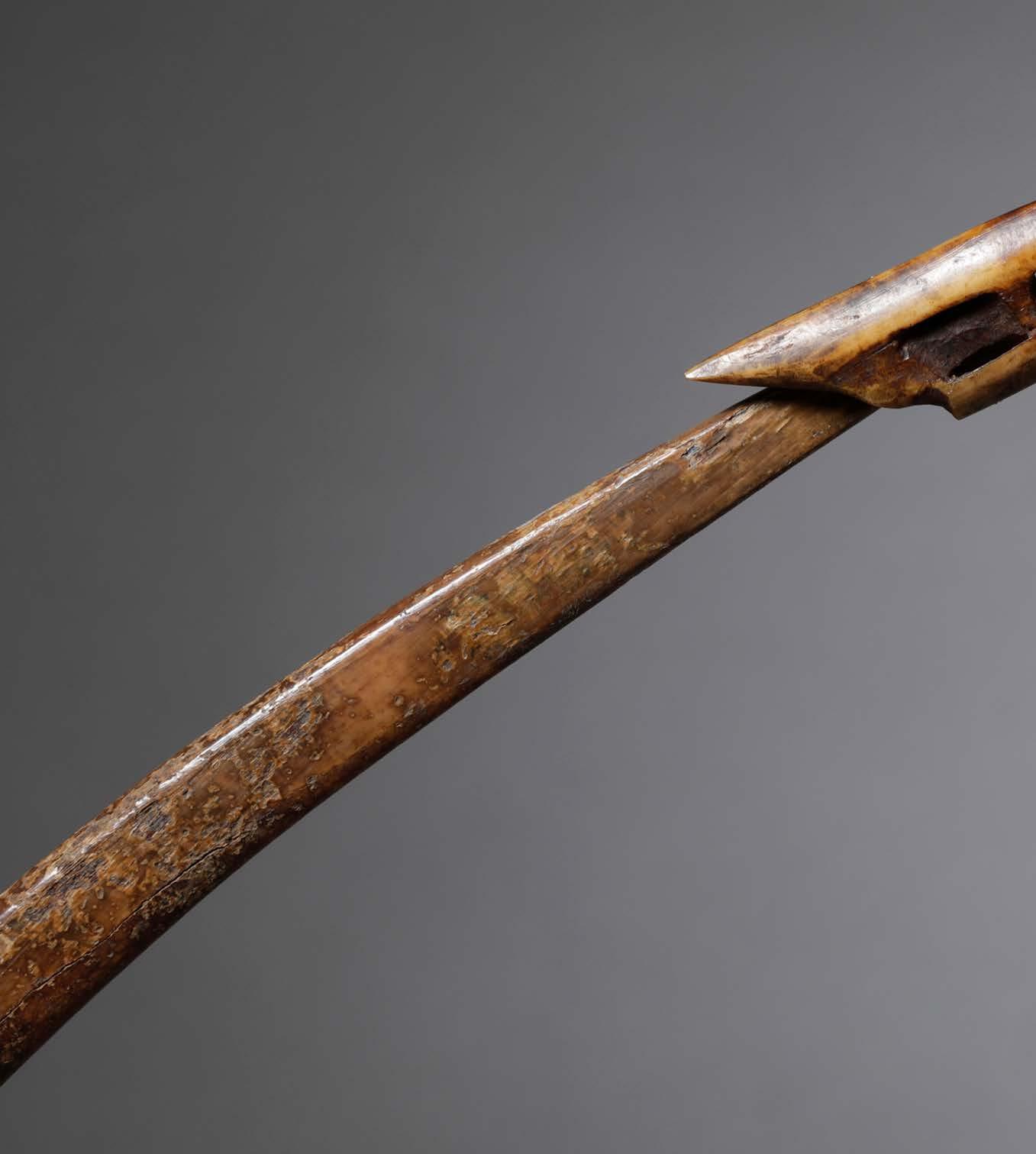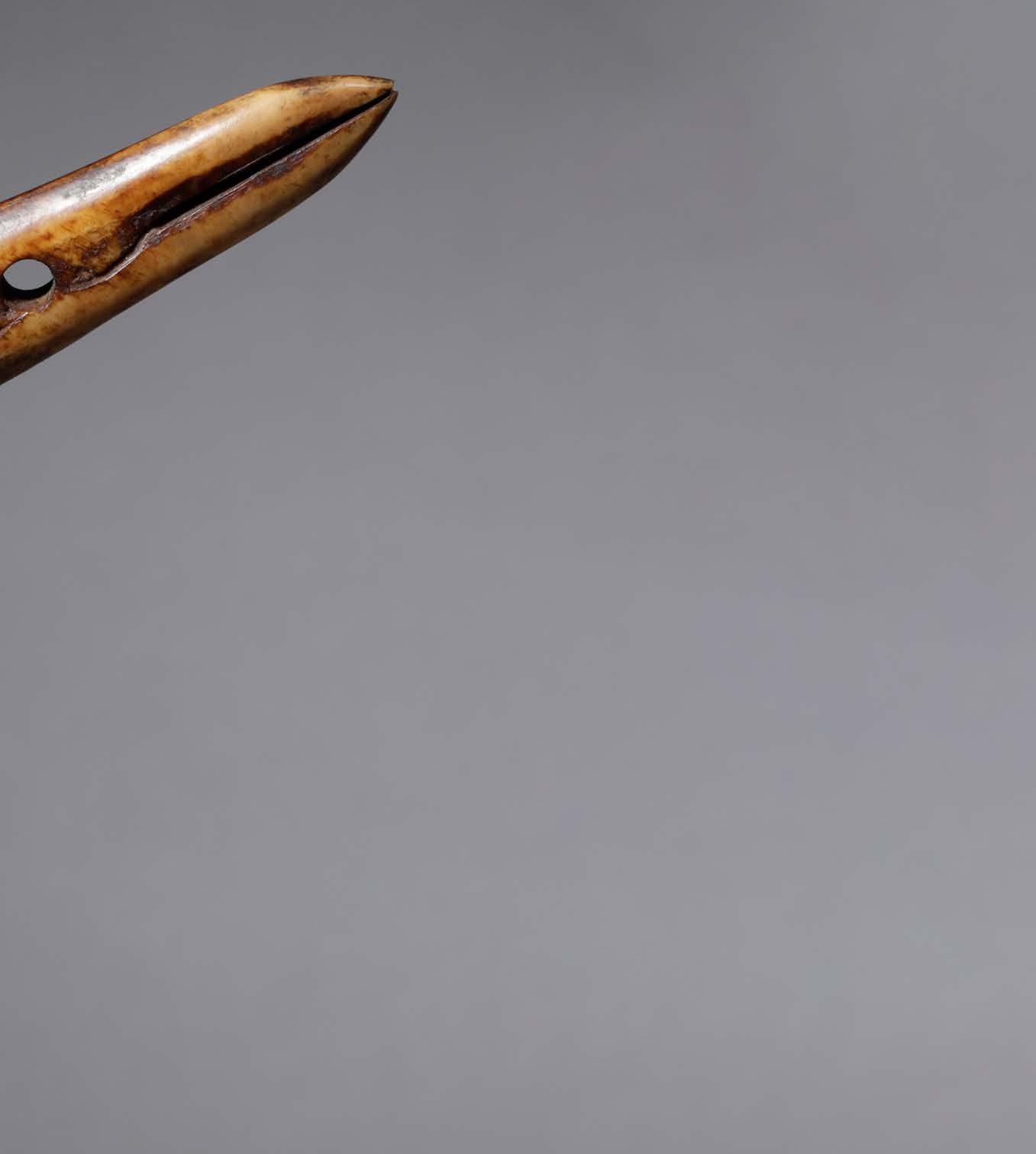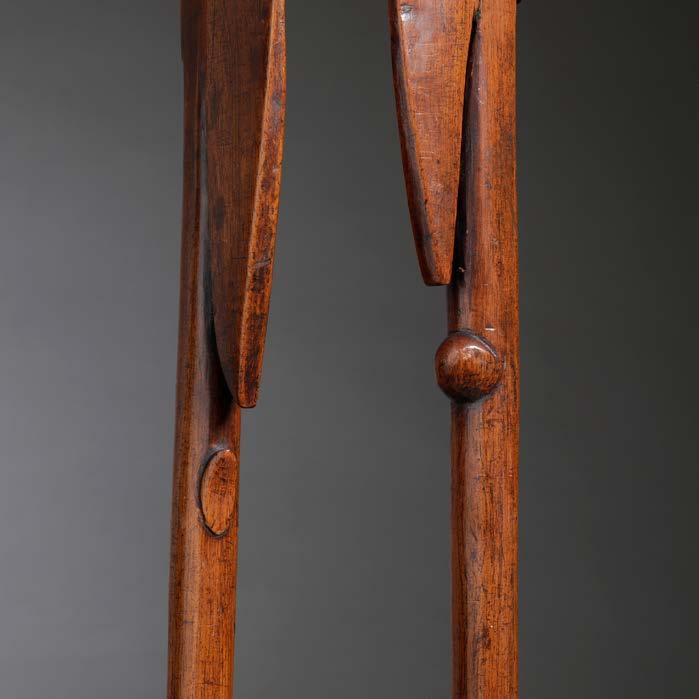NEW ACQUISITIONS
WINTER 2022–2023





 ART AND ANTIQUES FROM AFRICA, OCEANIA AND THE AMERICAS
ART AND ANTIQUES FROM AFRICA, OCEANIA AND THE AMERICAS
www.jacarandatribal.com
dori@jacarandatribal.com
T +1 646-251-8528
New York City, NY 10025
© 2023, Jacaranda LLC
Published February, 2023
PRICES AVAILABLE ON REQUEST
We are pleased to present our latest online exhibition, New Acquisitions – Winter 2022–2023.
Comprising 22 exceptional objects from Africa, Oceania and North America, our selection includes both figurative and non-figurative works. Highlights include a rare Bassa mortar and pestle, a Lulua figure from the Josef Herman collection and a fine Baule female figure. We are also offering an exceptional walrus/human effigy, one of two known by the same hand, and coming from an old
New York private collection. We hope you will enjoy our offerings. Please contact us for more information including price lists, condition reports and additional images. We will be attending Paris Tribal in April 2023 and hope to see many of you there!
Dori & Daniel Rootenberg new york city, february2023

Late 19th/early 20th century
Wood, metal, glass beads
Height: 10½ in
Allan Stone (1932–2006), New York, NY
Thence by descent to his heirs
This lovely Kamba figure, showing a subtle blend of features both stylized and naturalistic, is of a type connected with the ancestors and may have belonged to a magical practitioner (mundu mue, a benevolent sorcerer, or mundu mwoi, whose powers are used for the ill).
The present design shows a domed, powerful head with stoic visage and gazing, perforated metal eyes, its strength emphasized by a wide jaw, large ears and a stout, broad
neck encircled by a simple necklace. Its lightly poised arms flow gracefully down from the neck, and heavy feet and ankles on short legs anchor the figure’s stance. A single disc earring, one of an original pair, is still attached at the right ear. The suggestion of a coiffure is achieved by a texturing effect to the wood surface of the head, upon which rests a peaked metal cap.
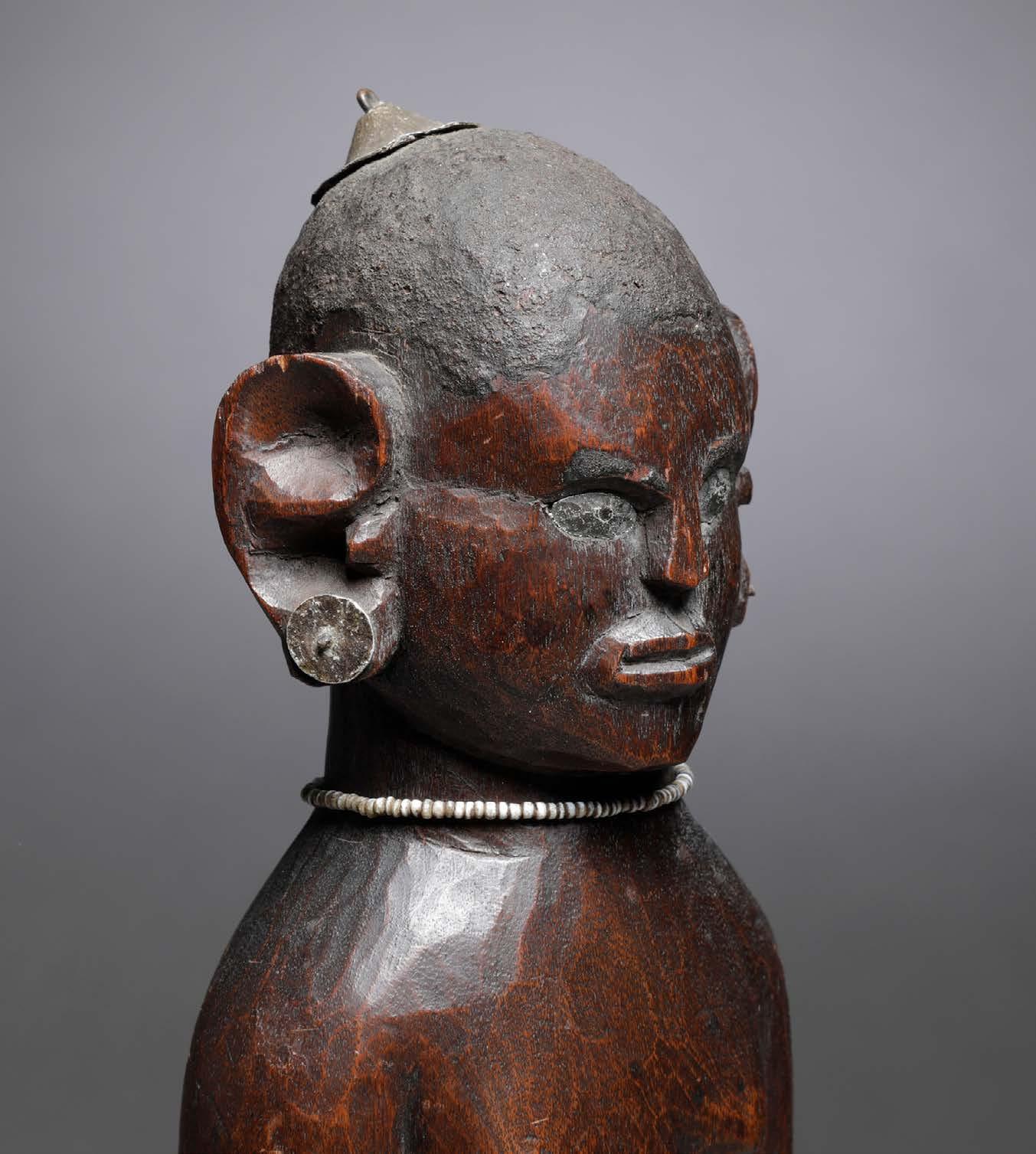
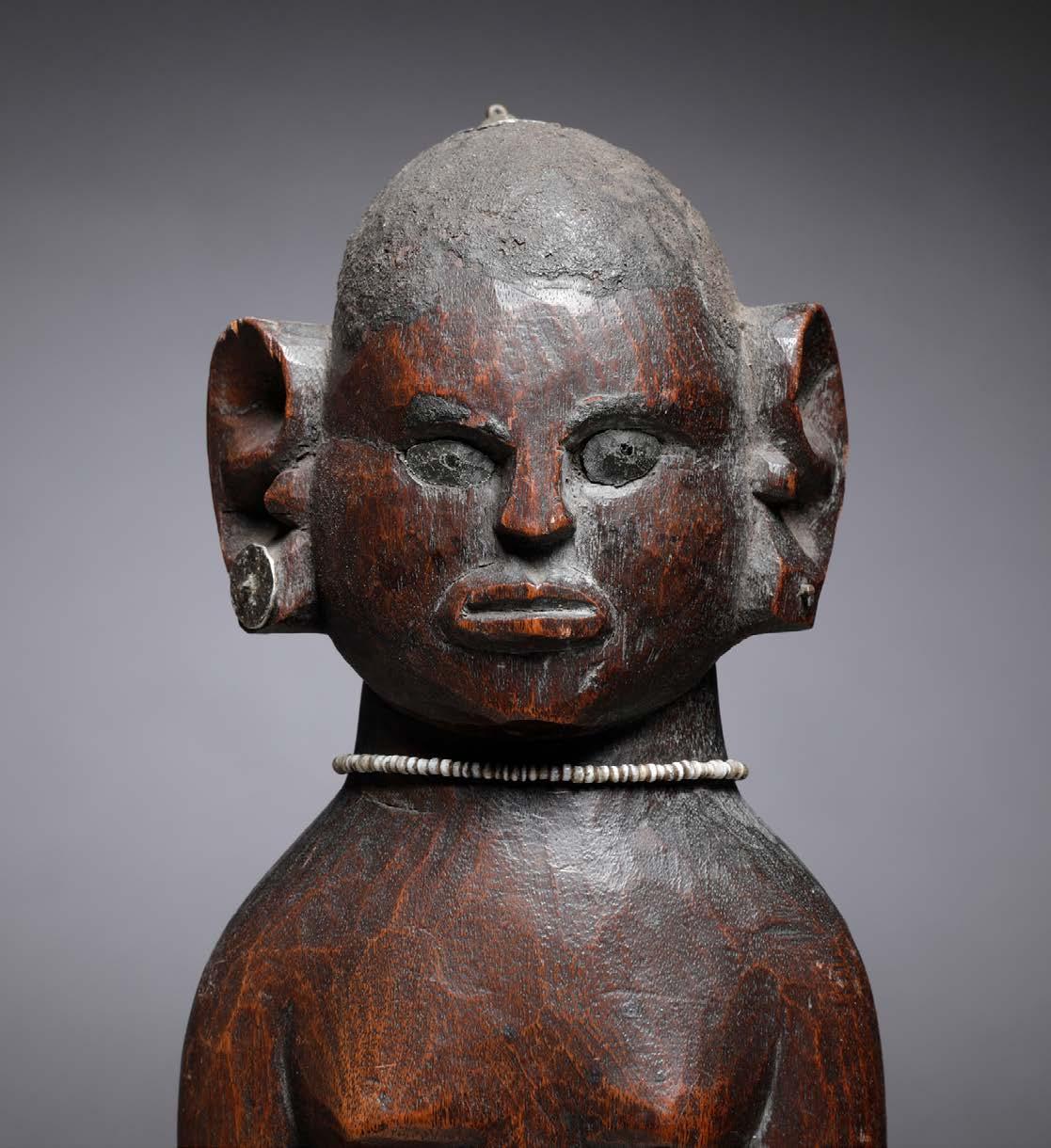




Late 19th/early 20th century
Wood, glass beads, organic material
Height: 9¼ in
René Guyot (1927–1979), Switzerland. Guyot field-collected in Liberia from 1969–1975.
Thence by descent through the family
Craig DeLora, New JerseyBRUNEAF, Brussels Non European Art Fair XXI’, 8–12 June 2011 and published in accompanying catalog
This mortar and pestle is a truly unique example of Bassa figurative carving. Bassa artists predominantly produce masks used by women’s and men’s secret societies, though their talents are sometimes turned toward a small range of other carvings, including simple, geometric mortars used for tobacco, cassava, and rice. Full-bodied figures are also occasionally made for narrow roles pertaining to divination and curing rituals. The fusion of these sculptural modes in the present piece is highly unusual. It is difficult to say with certainty how exactly it was used, but judging by the small and spoon-like form of the pestle (not pictured), it appears likely that it was employed by a ritual herbalist to create small quantities of ‘medicines.’
The formal beauty of this carving, however, is not in doubt. This is a splendidly executed work. It features the
prominent head and tightly ridged coiffure typical to Bassa figures, while a masterful softness and subtlety shown in the handling of the face and the fine, slender arms lend it an exquisite air of refinement and grace. The highly naturalistic face is shaped with gentle folds and is marvelously accentuated with blue glass trade beads set in the eyes, a detail rarely seen in Bassa art. The hard ironwood surfaces of the piece show a deep, warm brown and significant smoothing from generations of use, with traces of ritual substances found still encrusted on the pestle.
This piece was field-collected by Rene Guyot in Liberia between 1969 and 1975. Guyot was one of the foremost collectors in that region of Africa during the 1960s and 1970s, and many of his acquisitions reside today in important international collections and museums. Along with a number of other objects, this mortar and pestle was housed in a warehouse of Guyot’s and was unseen by the public from 1975 until the late 2000s.
Sold together with a one page write-up on the mortar and pestle prepared by William Siegmann, late Curator Emeritus of the Arts of Africa and the Pacific Islands at the Brooklyn Museum. Siegmann conducted extensive fieldwork in Liberia in the 1970s.
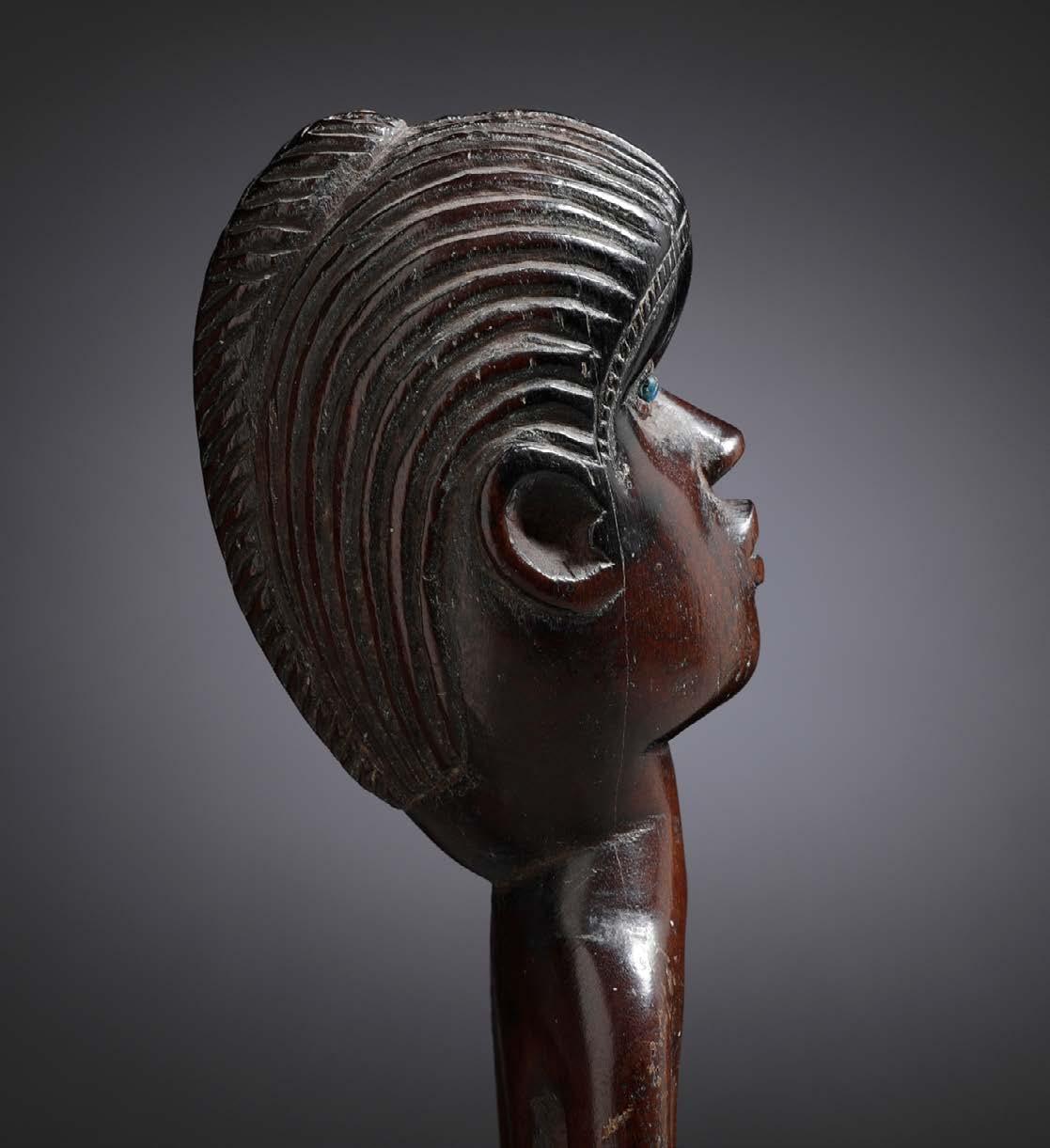
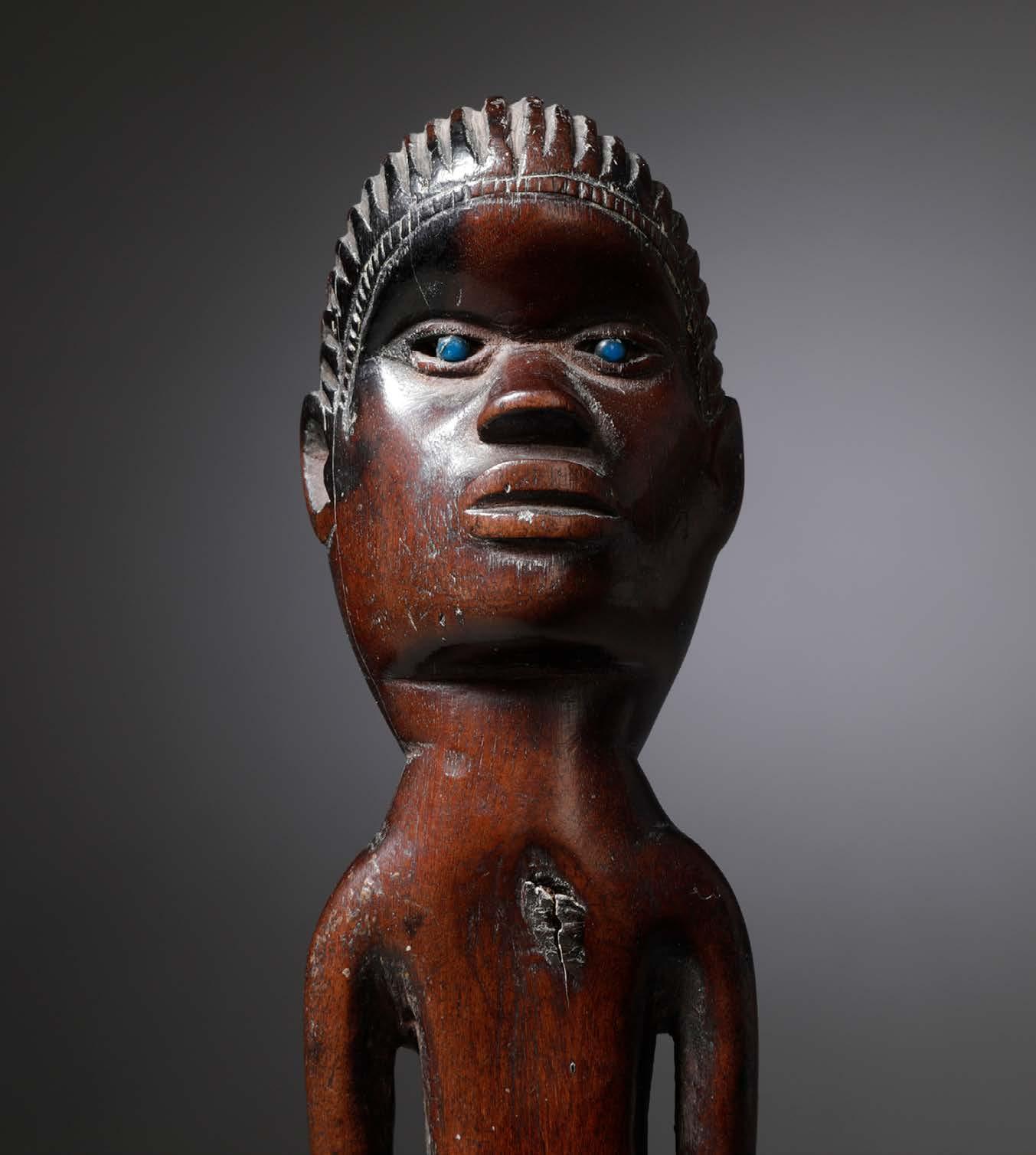

19th century
Horn or bone
Height: 6¾ in
Rick Gallagher, New York
The Dengese and their Kuba neighbors produce figures depicting high-ranking male authorities. Those of the Dengese portray the itoci, initiated men with powerful social status, while the Kuba works, called ndop, are idealized images of the king (nyim). In both instances, the subjects are often kneeling or seated (cross-legged, in the case of the Kuba) and are identified by their distinctive headdresses. The itoci headdress is quite flat, flaring back to both sides from the top of the forehead, and is surmounted by a type of horn or cylinder. The nyim wears a short, columnar crown with a forward-projecting shelf. These aesthetic similarities may be just one reflection of an intertwined political history shared by the Dengense and Kuba.
The characteristic images of itoci and ndop are echoed in this wooden amulet, which shows an elongated head wearing a cap or coiffure out of which rises a truncated, inverted cone. It is possible this piece may have been worn by a dignitary as an accessory or insignia. This small carving displays a wonderful sculptural rhythm in a descending cascade of shelved forms from the top of the headdress past the ears, slipping smoothly down to a long, tapered point and stretching the lower half of the face with it. A group of subtle, encircling incisions adds a touch of detail at the ‘neck.’ The features of the face and head are polished smooth from use, giving bright highlights over the dark patina.

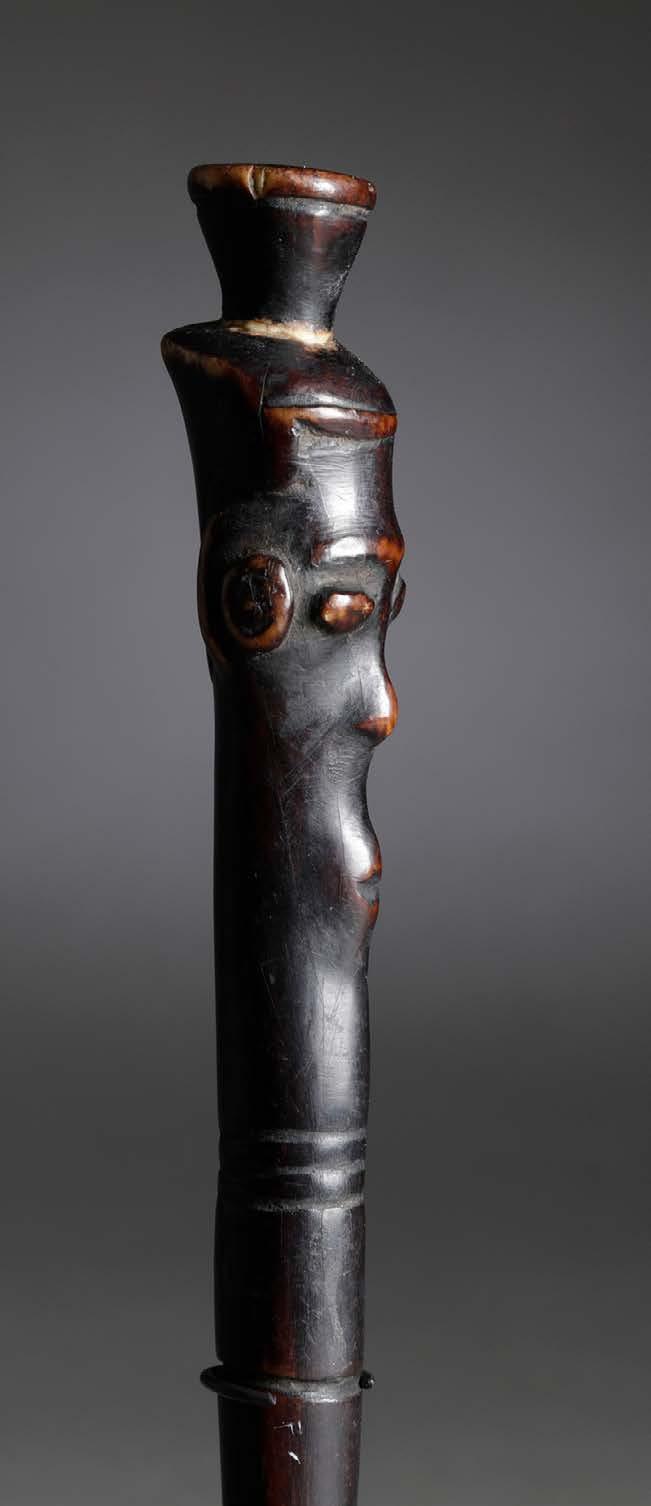
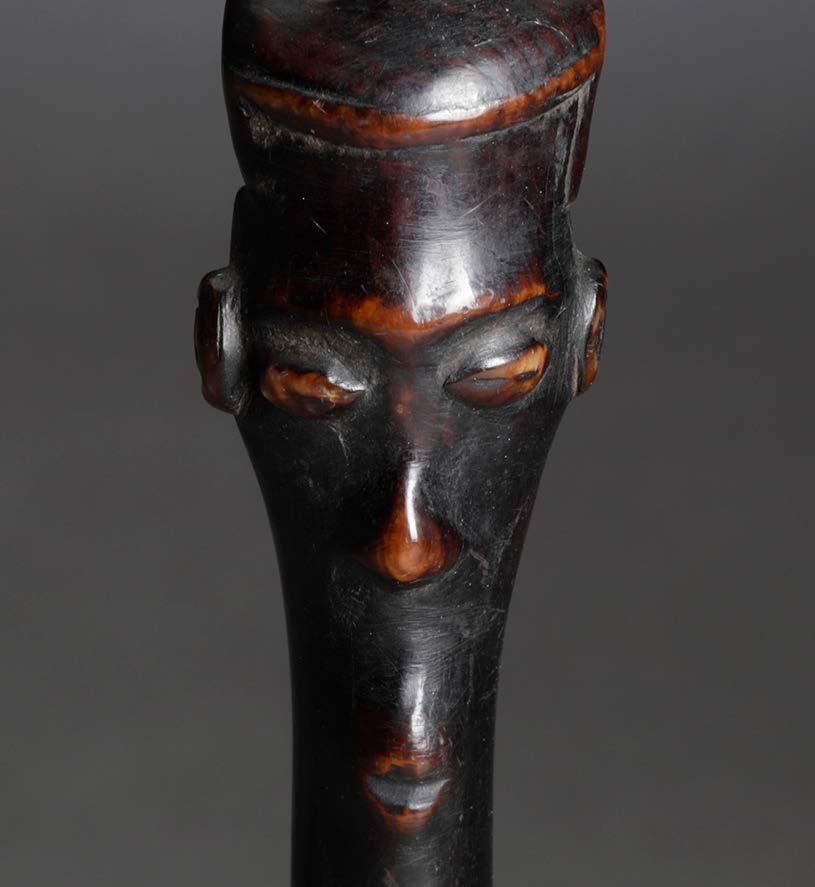
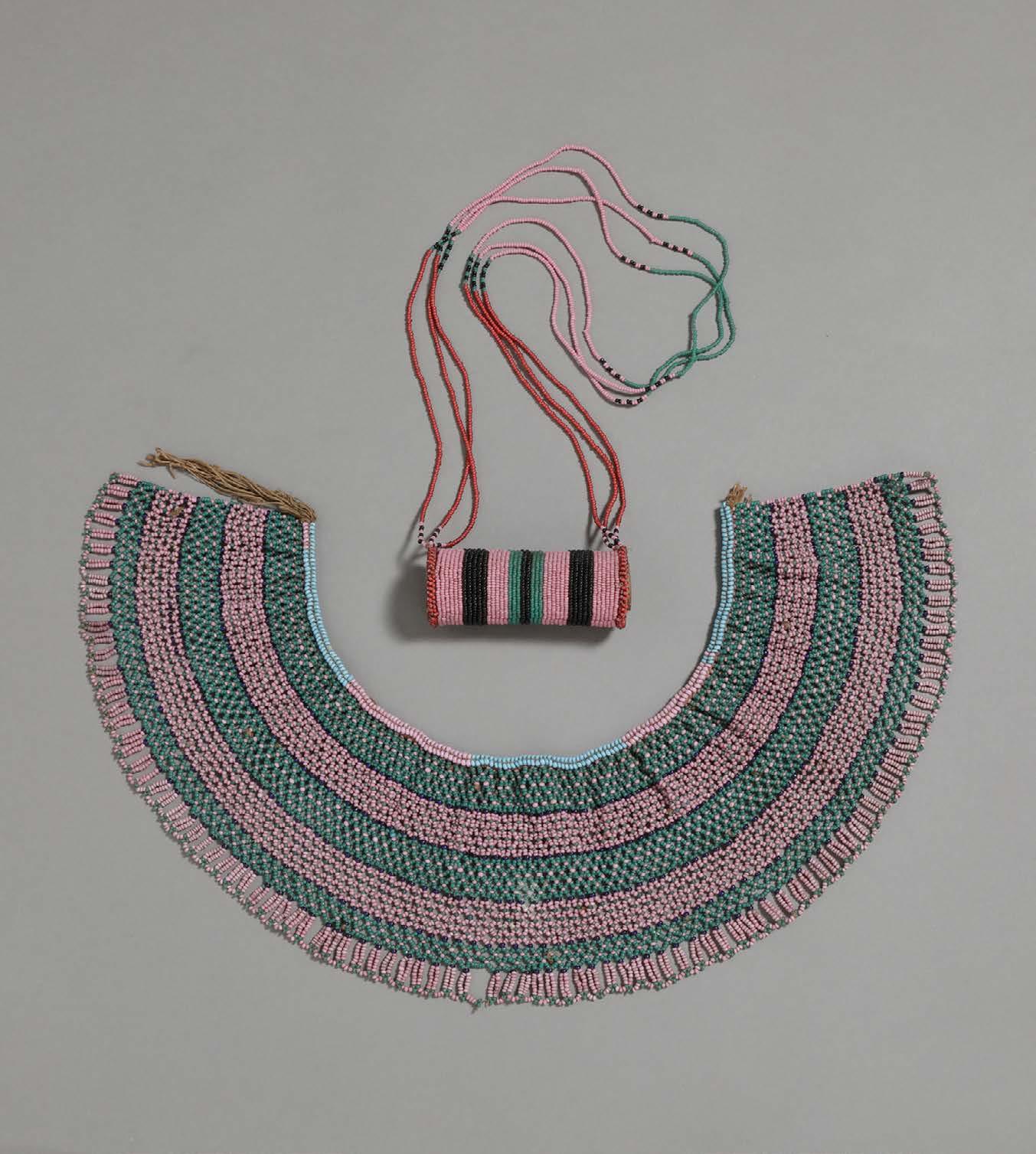
XHOSA (COLLAR) AND ZULU (SNUFF BOTTLE), SOUTH AFRICA
Glass beads, sinew, fiber, wood
Late 19th century
Collar: Width: 15 in
Snuff container: Width (of bottle): 3½ in
PROVENANCE
Private UK collection
Beadwork ornamentation and accessories were once ubiquitous in southern African societies. Worn by both men and women in dazzling, layered ensembles, they clothed the body, caught the eye, and reflected social status.
The pair of pieces offered here represent a typical portion of everyday ornament for the Zulu and Xhosa. They are particularly fine and old, crafted with very small glass beads and preserved in excellent condition. A classic regional
color scheme of pink, green, and black is shown to beautiful effect in their banded designs. While the broad collar was predominantly decorative, possibly crafted and given to the wearer as a token of affection by an admirer, the snuff container would have seen continual use in a social milieu that heavily emphasized the mood-altering effects of tobacco.

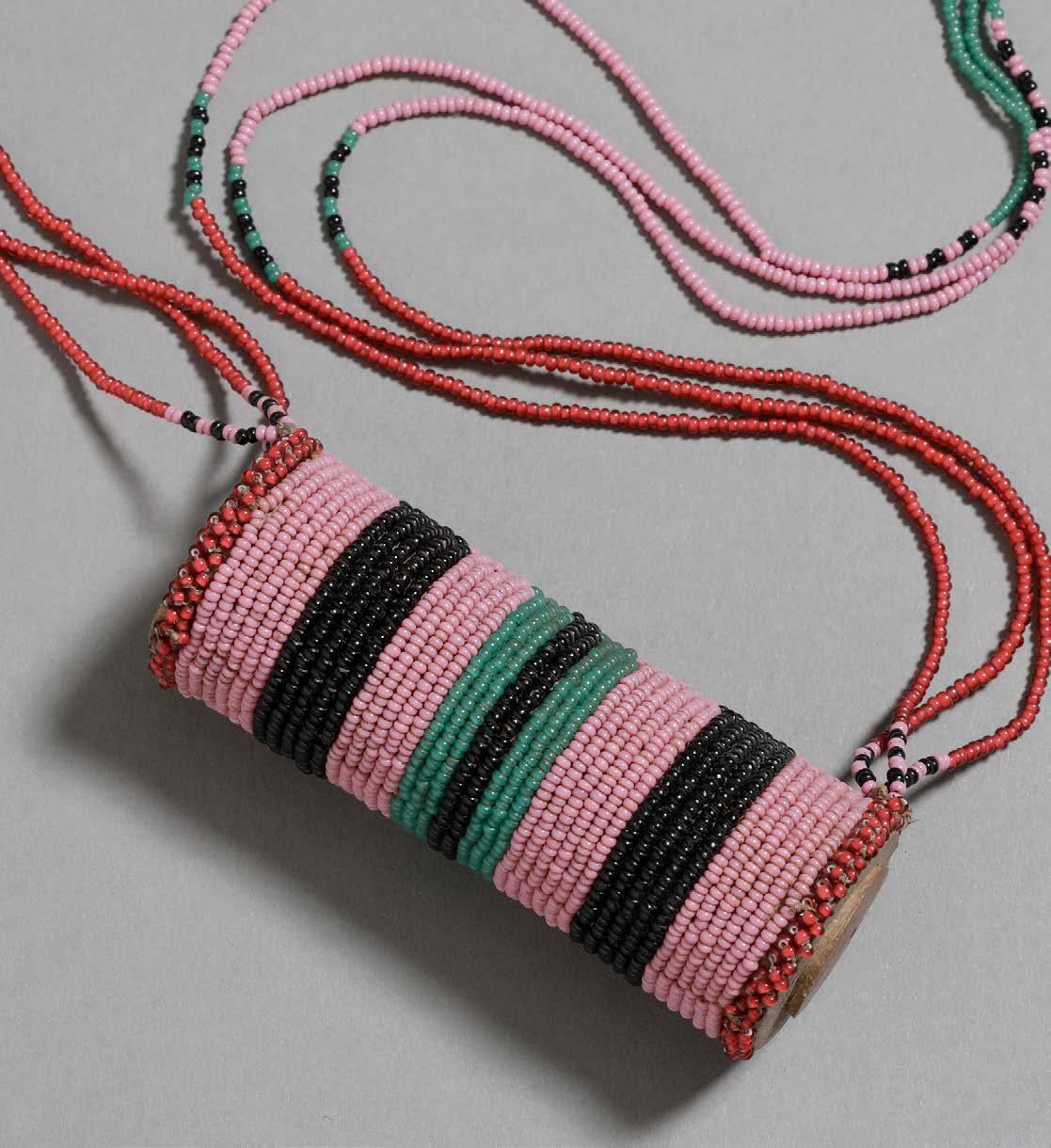
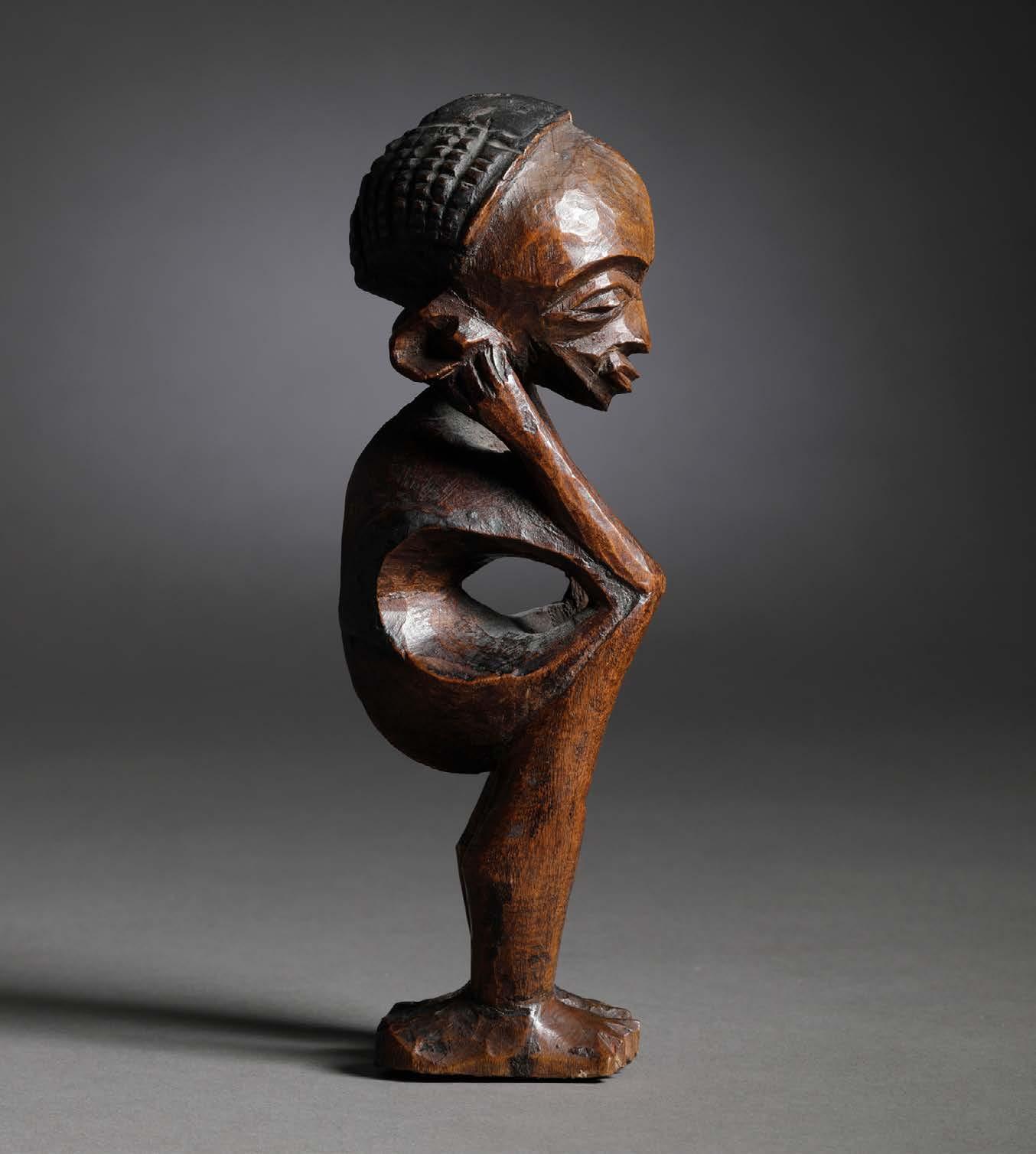
LULUA, DRC
Wood
19th century
Height: 6 in
Josef Herman (1911–2000), Suffolk, England
Christie’s, Amsterdam. December 12, 2000, lot 329
Private Collection, New York
William Buller Fagg, foreword by Josef Herman. Miniature Wood Carvings of Africa. Adams & Dart, 1970: 89, fig. 86.
Scottish National Gallery of Modern Art, Edinburgh, Scotland.
African and New Guinea Sculpture from the Josef Herman Collection: paintings and drawings by Josef Herman. 19 July – 17 August 1969: no. 33.
‘African and New Guinea Sculpture from the Josef Herman Collection: paintings and drawings by Josef Herman’, Scottish National Gallery of Modern Art, Edinburgh. 19 July – 17 August 1969
In the Lulua statuary corpus there is a class of small, thin, crouching male figures, distinctively posed in a taut elbow-to-knee posture, with hands held to the side of the head or neck, or supporting the chin. The exact nature and symbolism of these figures has been the subject of numerous theories. They are sometimes described as hunting charms that would be attached to a man’s girdle, their unique pose depicting a hunter exhaling ritual
cannabis smoke onto the figure to ensure a successful hunt. Elsewhere they are posited to be apotropaic figures intended to ward off disease, to act as intermediaries with the spirit world, or to portray a chief in a state of deep contemplation. Particularities in pose (for example, the hands held to the side of the head as opposed to on the chin or neck) may correspond to specific meanings in these figures.
The present figurine is a splendid example of its type. Viewed from the front, it is rather rigidly vertical in silhouette; viewed from the side, it reveals an entirely different aspect, full of swelling curves and strong angles. The artist has played with abstraction in the folded form, completely fusing the elbows to the knees and creating a strong, closed teardrop shape in the center of the piece. There is a palpable sculptural tension created in this approach and the figure appears about to spring into motion at any moment. The outsized head is noteworthy, carved masterfully on this small scale with a group of crisp and nuanced forms that read somewhat naturalistically, lending a unique personality and great character to the figure.
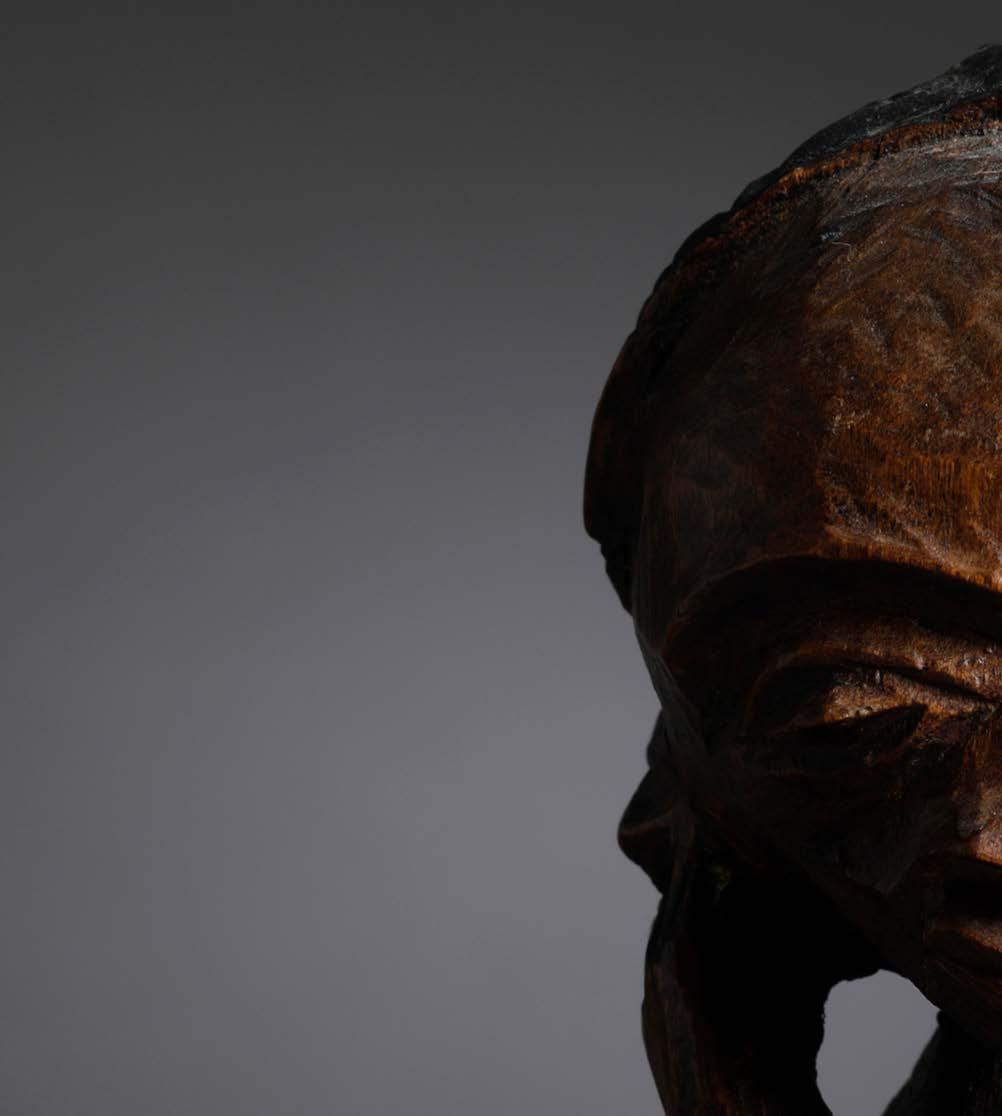

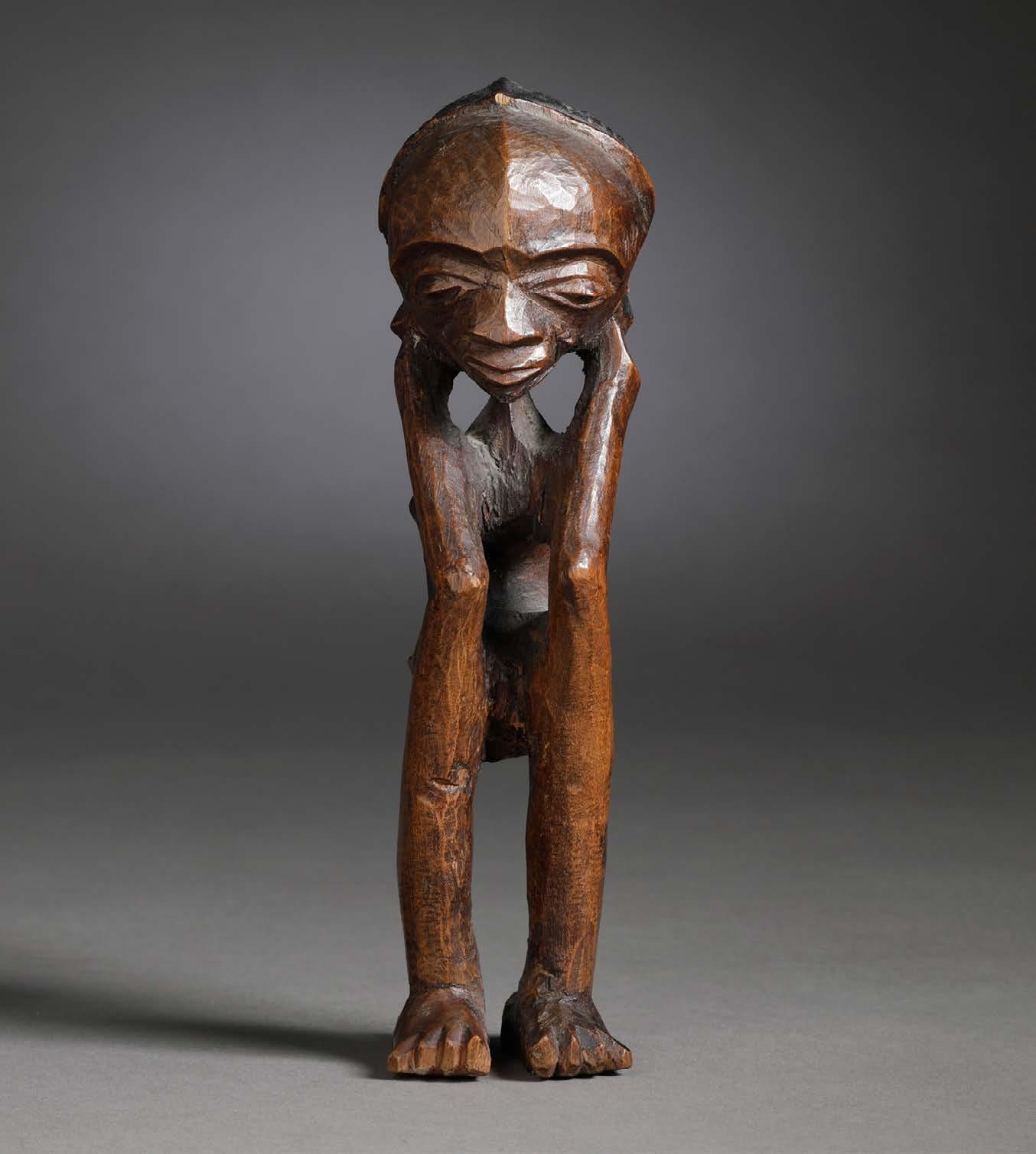
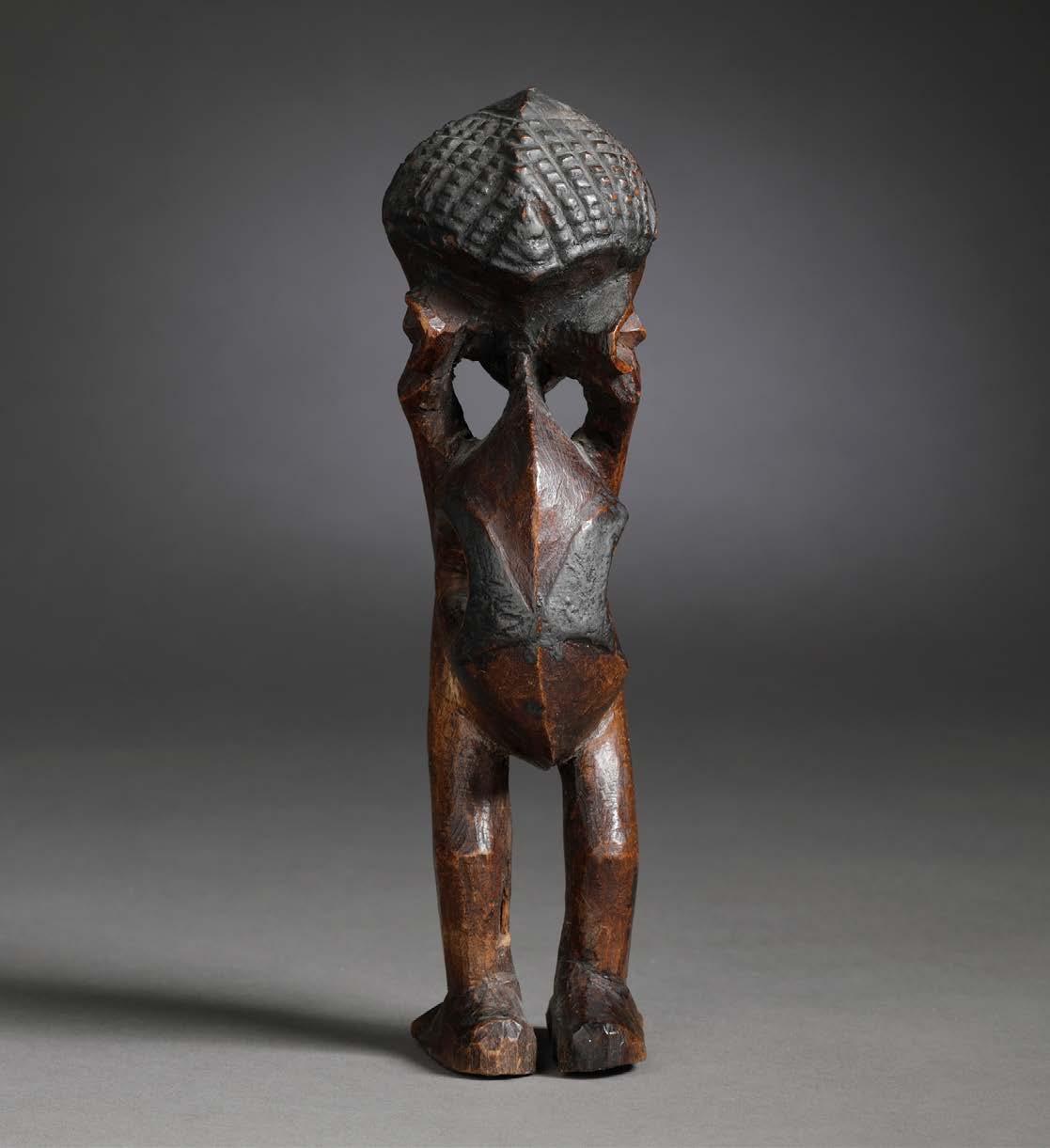

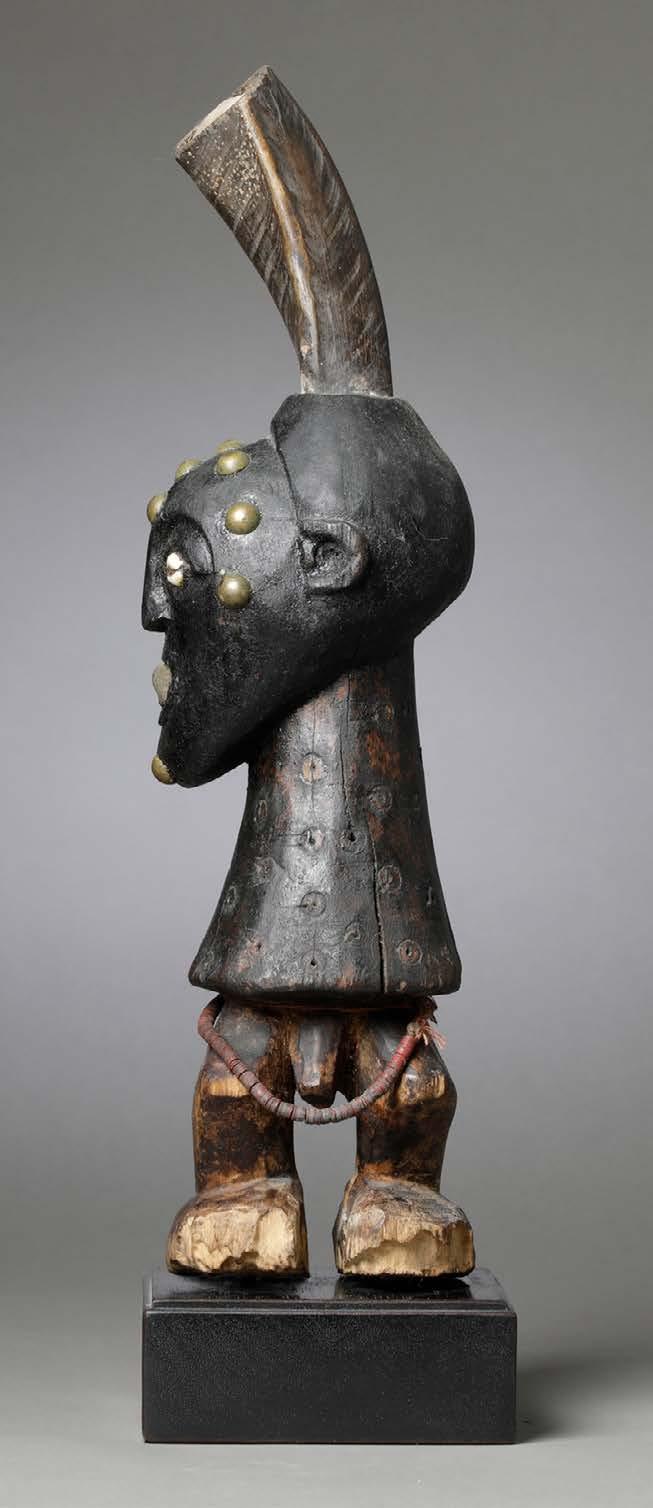
Late 19th century
Wood, horn, shells, nails, organic substances
Height: 13 in
Frederic Poutchkovsky, Pau, France
Adrian Schlag, Brussels, 2008
Songye artists are famed for their masks and statuary, which are highly stylized and often striking in their sculptural power. Representations of males and females abound in Songye tradition, each having a characteristic style and individuality. These carvings were largely used within secret societies as power objects, channeling spiritual forces to protect or assist the owner or the greater community.
While many Songye power figures (nkisi, pl. minkisi) stand facing frontally, this figure takes a less conventional posture with its face turned ninety degrees to the right. Here a pair of small legs supports a broad neck and mask-like head with open mouth and alert, wide eyes set with small cowrie shells. The brow and chin are decorated with brass
tacks, a common embellishment in Songye statuary. These show well against the dark surface of the figure, which has been deeply developed through saturation with palm oil. A slender, coral-colored shell necklace encircles the figure at the waist.
Projecting from the crown of the head is a large segment of animal horn holding a magical charge (boanga) made by a ritual practitioner. Composed of potent organic ingredients, paste-like preparations of boanga were placed in hollows in the torsos or heads of power figures to endow them with magical efficacy, also found in the open mouth of this example.
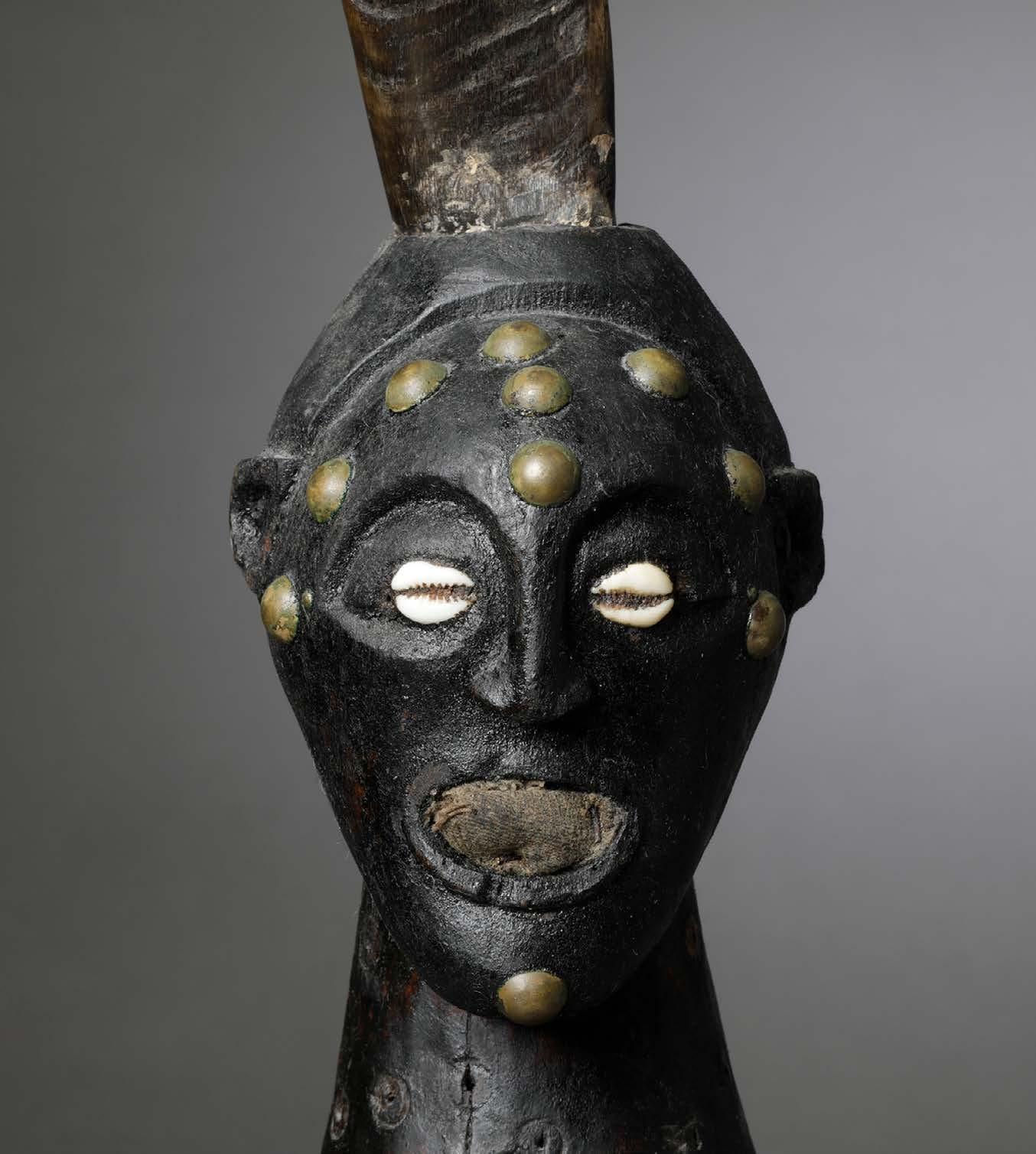
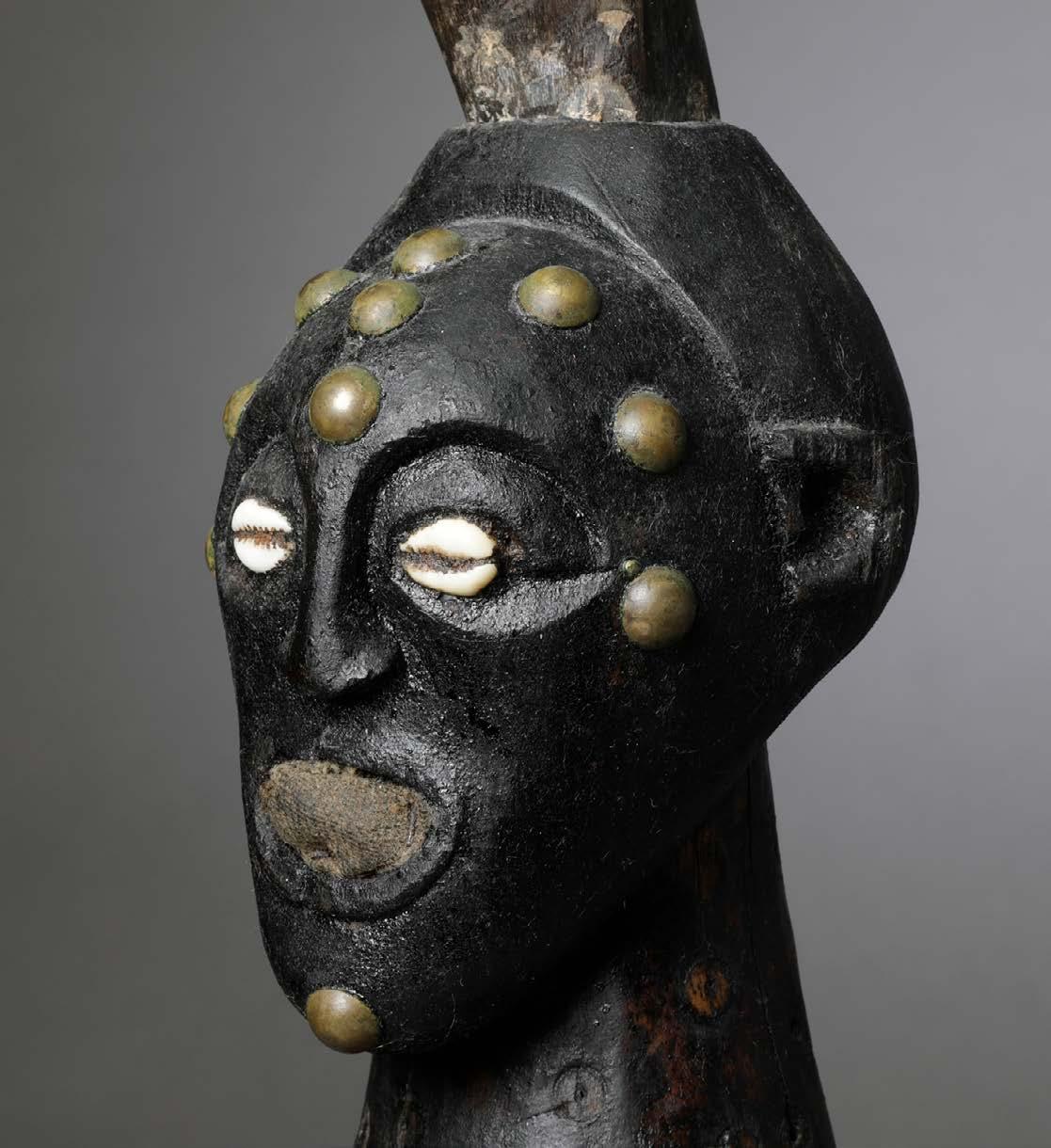
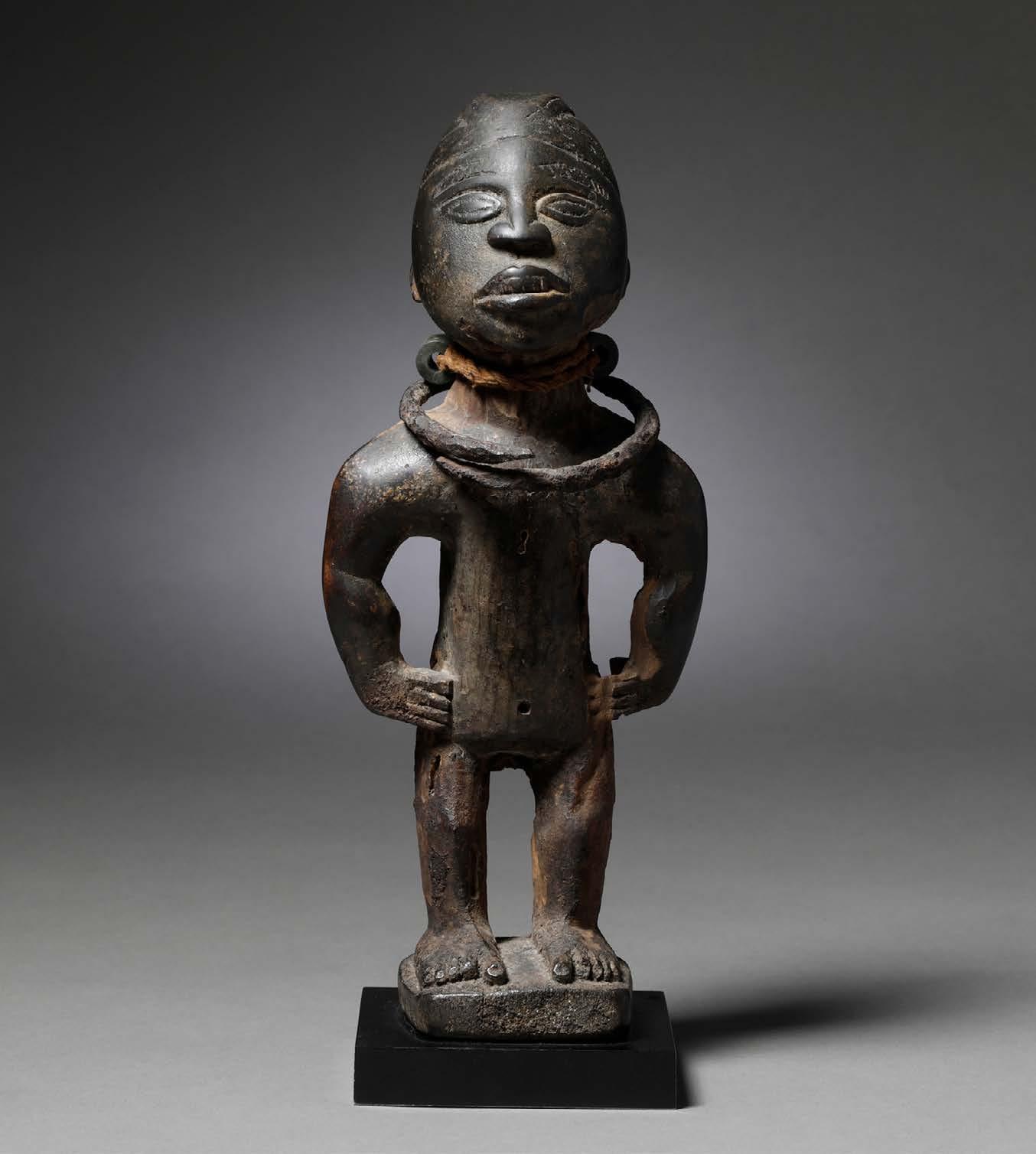
Late 19th century
Wood, metal, fiber, glass beads
Height: 9 in
Kristin M. Jefferson, New York, 1993
Private collection, New York
Renowned for their arresting sculptural presence, Kongo power figures represent one of the most iconic art forms of central Africa. Created collaboratively by an artist and a ritual specialist (nganga), they are conceived to house potent mystical forces and bear stern witness to critical community affairs.
Nkisi (pl. minkisi) is both the name of a spirit and a figure that can be made to contain it. The nganga empowers the figure by embedding animal and plant substances into it, often in a cavity on the stomach, which is covered by a mirror. Thus charged, the nkisi is able to identify and attack a sorcerer who may be causing harm to certain individuals or the community at large; as well, minkisi were used to resolve conflicts among tribe members. Many minkisi are pierced with numerous nails and shards of metal, each of which attests to a resolution between members of the community or an effort to combat evil. While many minkisi brandish a dagger, indicating their role as avenger, some
stand with hands akimbo, suggesting their role as Supreme Being.
The nkisi offered here is of the latter description, standing confidently with muscular arms at its hips. Thick, broad shoulders and a weighty head project power and strength, and the expression of the face, with chin slightly raised, carries an imperious impression. Two necklaces, one beaded and one metal, are slung about the figure’s throat and shoulders. Both the projecting belly niche and the metal insertions typical of minkisi are missing in this figure, suggesting they may have been lost (possibly evidenced by the small holes found at various points on the torso) or the figure may not have been used in a ritual context. Despite the liberties in stylization the artist has taken with certain aspects of the anatomy, the hands and feet are carved with precision and lifelike character, with naturalistic placement of the thumbs and detailed, carefully executed toes.



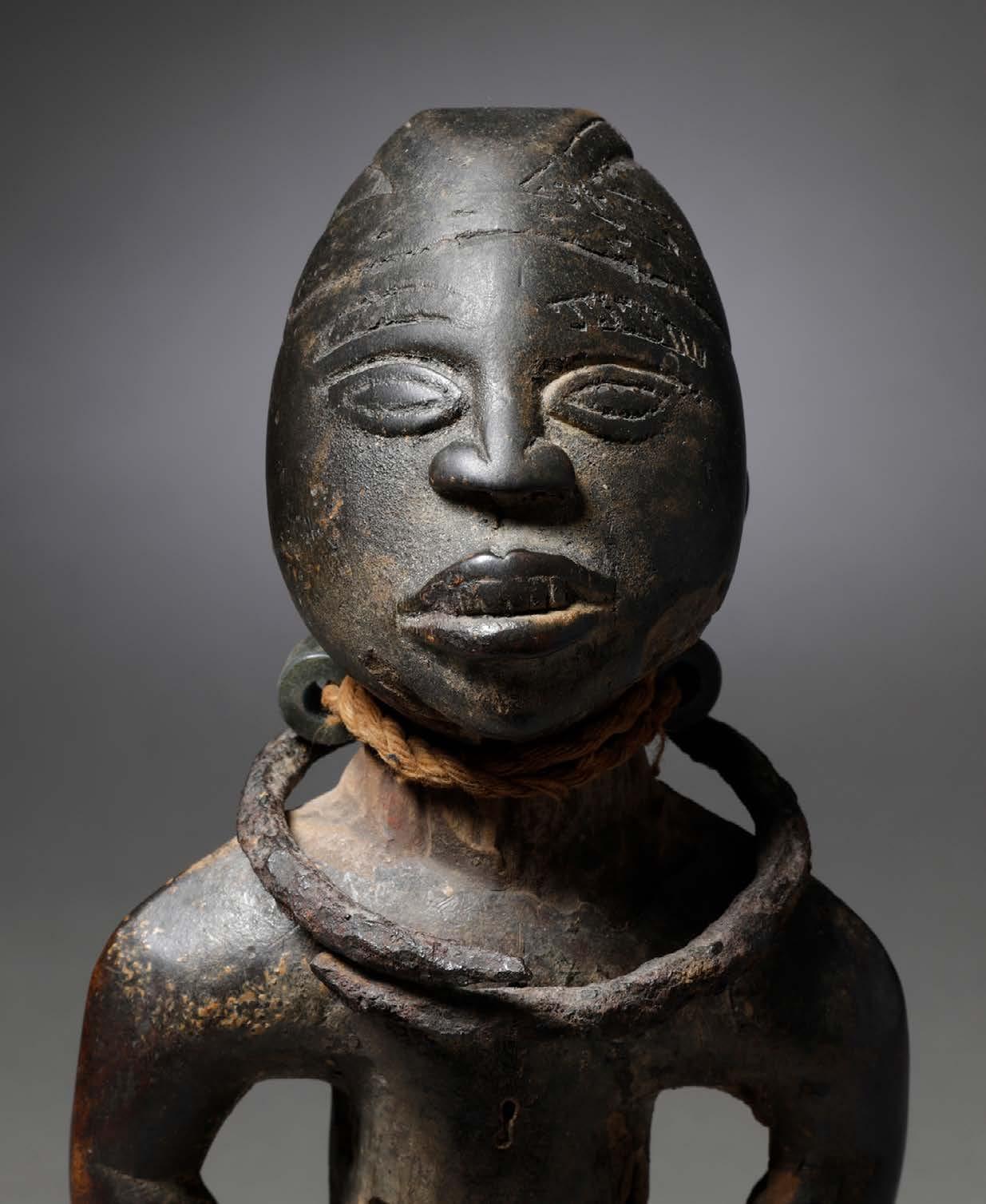

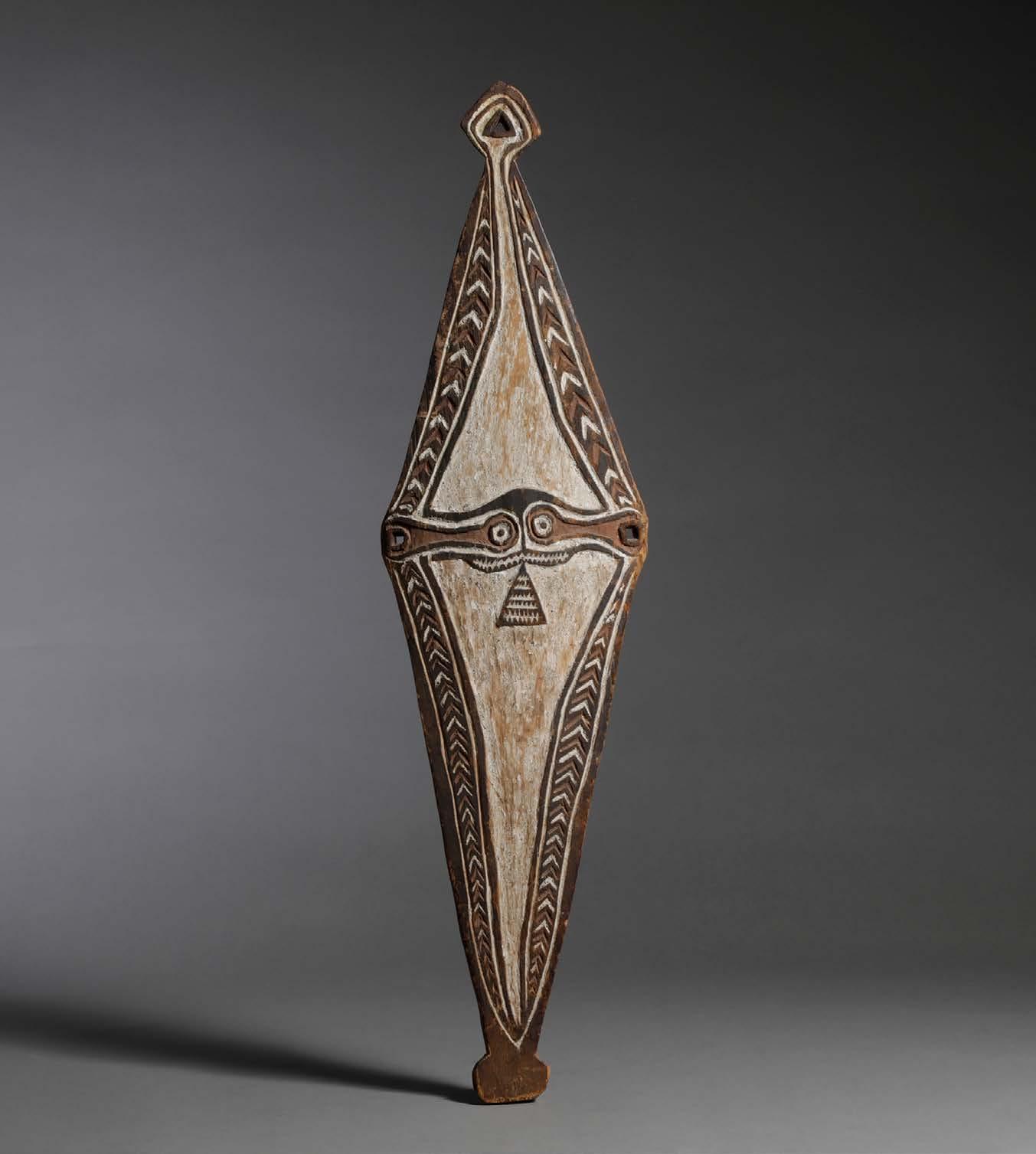
First half 20th century
Wood, pigment
Height: 35 in
PROVENANCE
Alex Phillips, Melbourne
Pierre Moos, Paris
Alex Arthur, Brussels
Private Collection, New York
PUBLICATION HISTORY
Virginia Lee-Webb: Embodied Spirits: Gope Boards from the Papuan Gulf illustrated on p. 169
In the Papuan Gulf region, the primary focus of traditional religious and artistic life rested on powerful spirits known as imunu. Each imunu typically was associated with a specific location in the landscape, rivers, or sea, and was linked to the specific clan whose territory encompassed that location. The peoples of the region represented and revered the imunu through the creation of spirit boards (gope), twodimensional carvings featuring figures and designs carved in low relief and colored with ochre and pigment. Each served as a dwelling place for an individual imunu, whose image appears on it.
Gope were installed in clan shrines inside huge, peakroofed men’s houses called ravi, where ceremonial objects were kept safe and hidden from the uninitiated. Accompanied by figures, skull racks, and other sacred
objects connected to a clan’s imunu, gope helped to guard their clanspeople from harm and aided them in headhunting and warfare, offering concealment and weakening enemies in advance of a raid.
The present gope shows a tapered, diamond-shaped silhouette, a somewhat atypical form that stands apart from the ovular or eye-shaped compositions more commonly seen in this carving tradition. Carved in low relief, the surface designs are brought out brilliantly by a strong contrast of well-preserved white and dark ochres. A hypnotic power lies in the gaze of the imunu, whose abstracted face peers out from the center of the board, connecting at its sides to the snake-like borders. Its strong horizontal thrust, pressing out to the limits of the diamond frame at its widest point, conjures an impression of the spirit pushing through a fissure from another plane.



Late 19th century
Wood Height: 7½ in
PROVENANCE
Private collection, New York
In Lobi society, figures were carved in embodiment of spirits (thila) who enforce divine laws governing the human sphere. The medium through whom the thila issued their wishes and guidance was the buor, or diviner. The various injunctions delivered through the buor sometimes included the creation of carved figures that were intended to fulfill curative or warding functions. Figures carved as a result of a divination are known as tibil thil (a person who helps the thila). Such figures were placed on public or family altars, and the rooms of dwellings included a small niche or space (thilda) for this purpose. From this position the spirit would protect the family and home from misfortune. It could also be used for divination, and could demand offerings and even the addition of further figures to accompany it. An
accumulation of spirit figures conferred social status upon a family, and they were passed through the patrilineal line as heirlooms.
Lobi figures take on a variety of poses and aspects, some relatively neutral and others animated. The present figure is a male example of the bateba phuwe (‘ordinary’ bateba) type, which stands frontally, arms to its sides. It shows a heavy-lidded, brooding expression, the energy of which is echoed forcefully by the rough geometric execution of the body. The back of the head mimics the front, making janus-like. In profile, the form reveals a highly abstracted assemblage of fused and angular shapes that project a sense of the monumental.
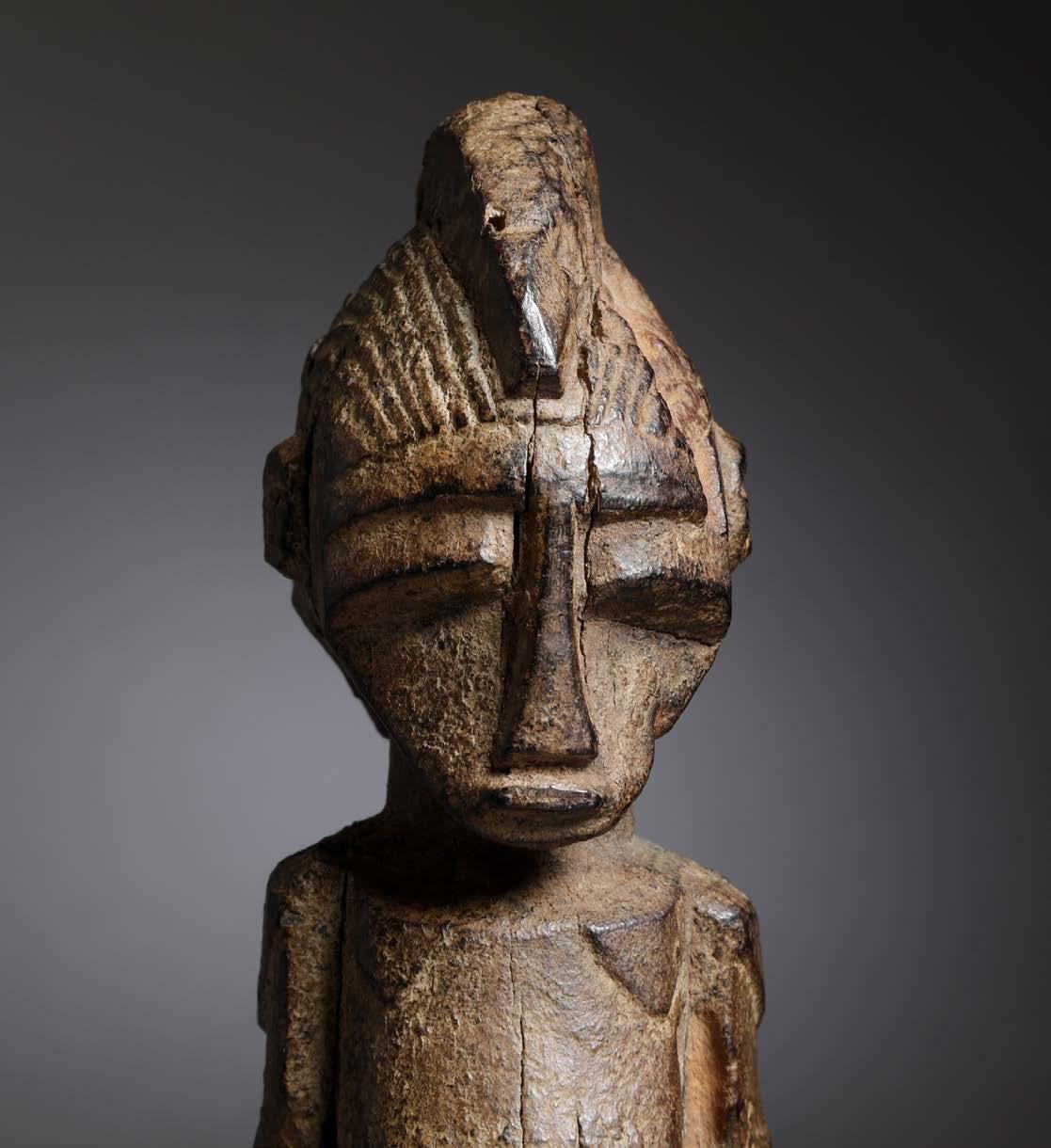
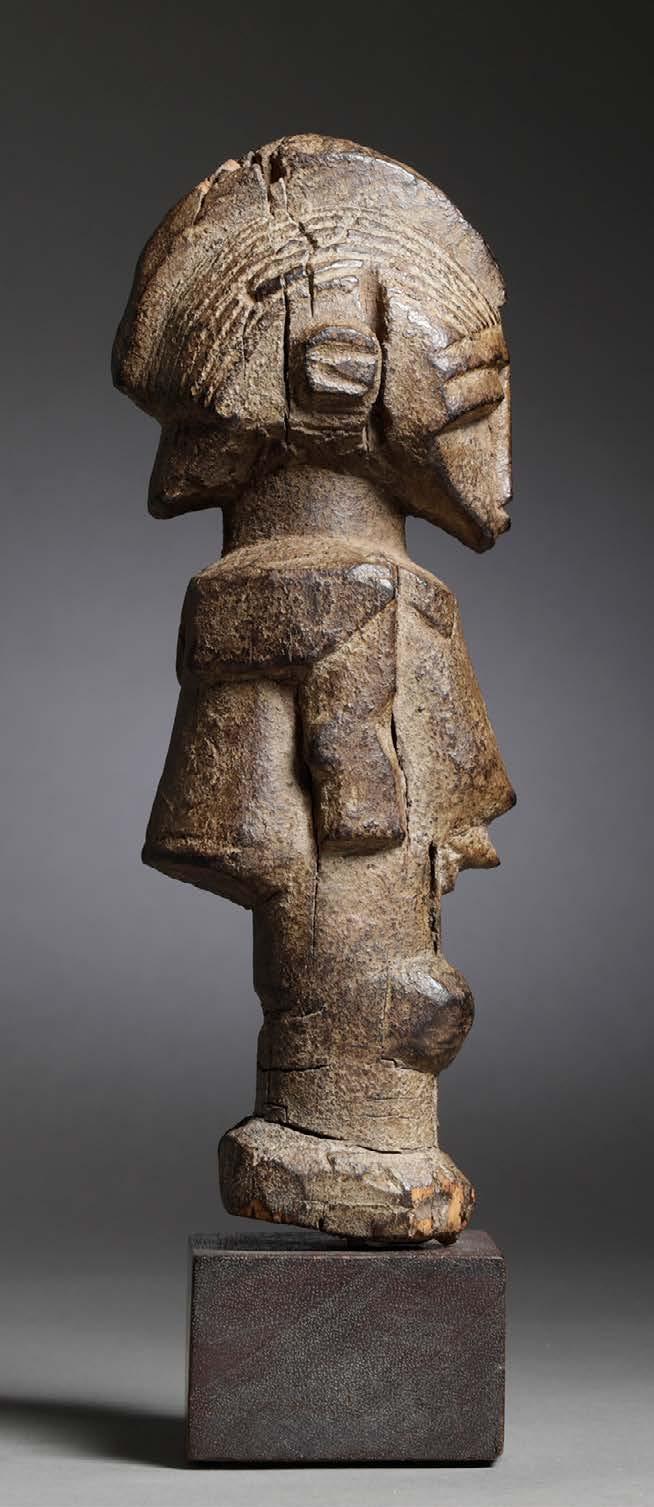
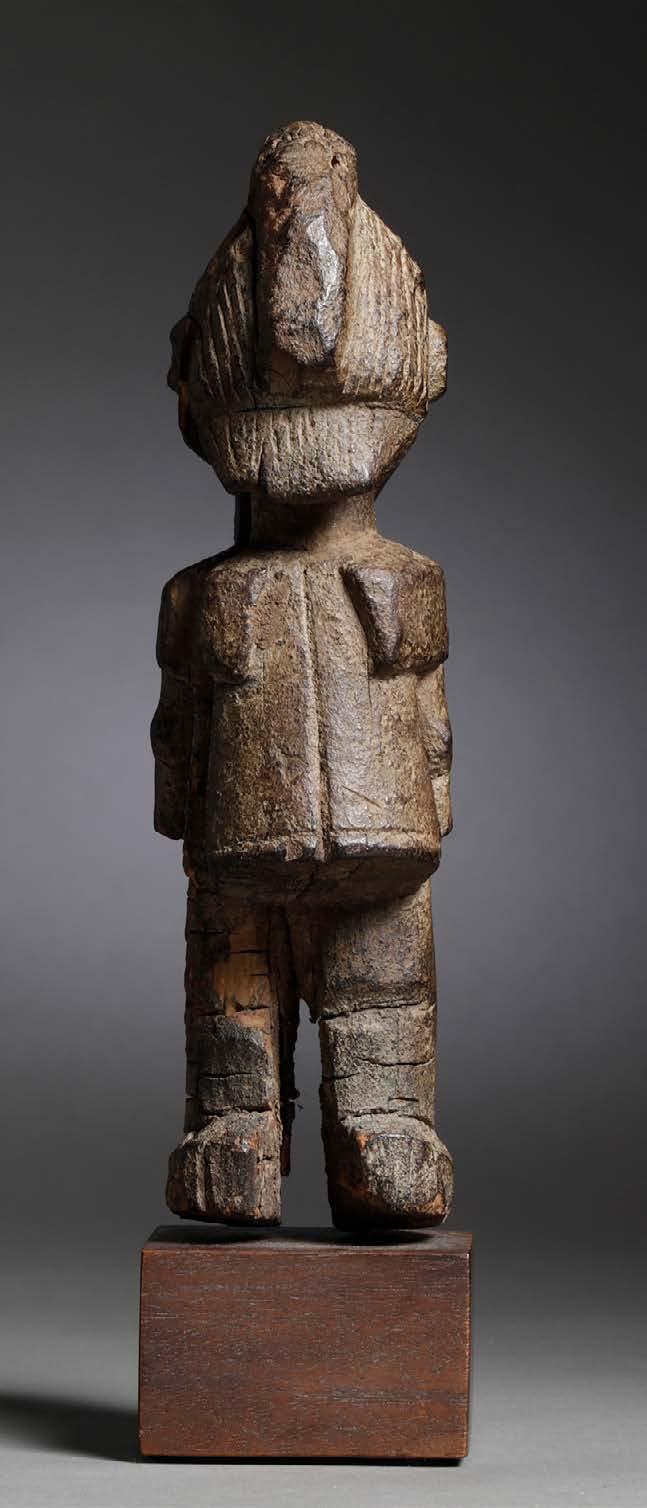
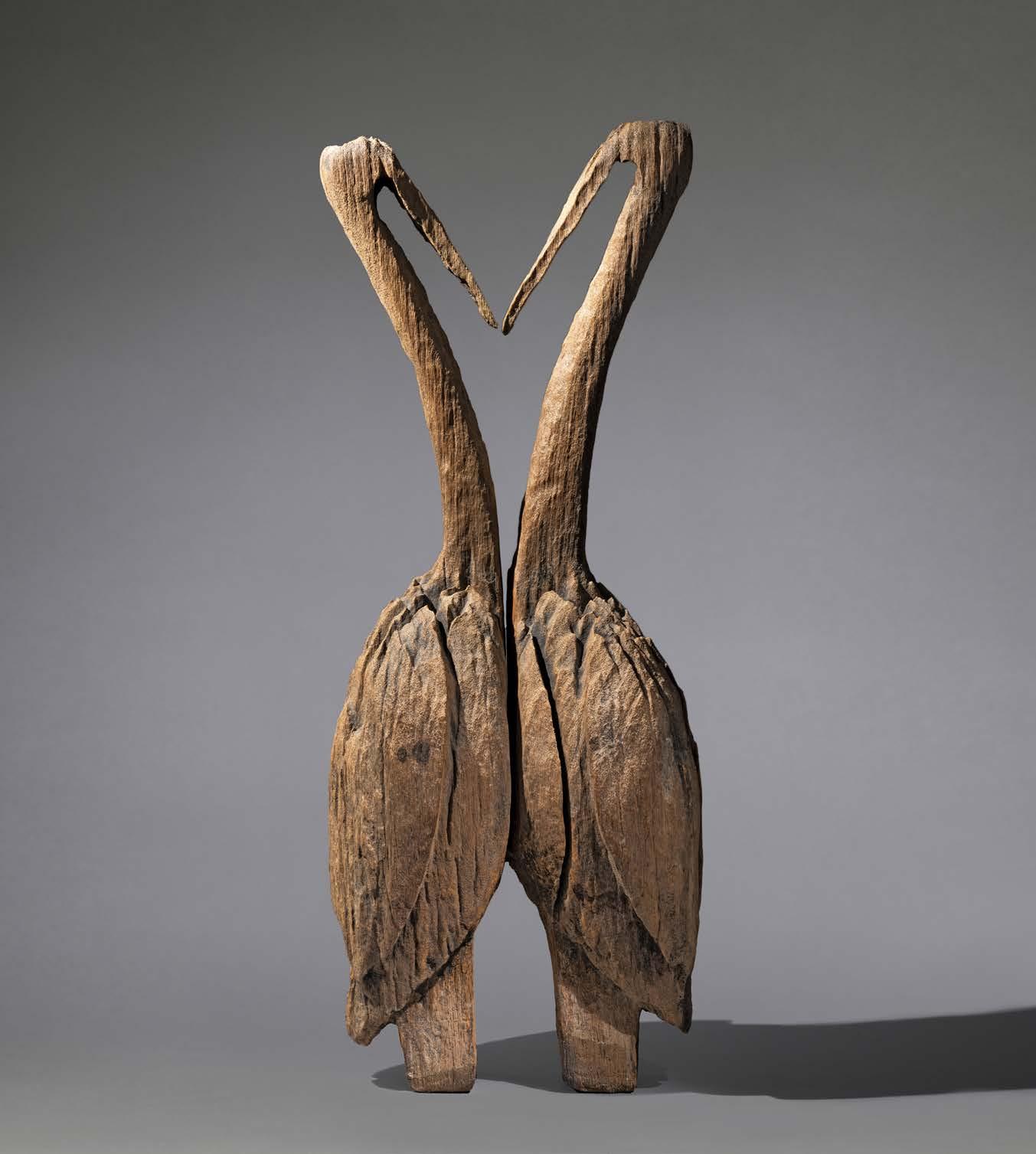
Late 19th century
Wood Height: 28 in
PROVENANCE
Private collection, Belgium
The earliest figurative form to have emerged in Sakalava funerary sculpture is that of the bird, portrayed either alone or as a pair. The specific theme of the ibis (mijoa) is thought to embody the interconnection of the worlds of the living and the afterlife. Taken together, the statuary invokes the memory, balance, partnership and symmetry of the two planes. As funerary monuments, the carvings served to memorialize an important community figure.
The present example shows the strength of its symbolism in the pair of ibis, or aloala, which stand closely before one another, a mirror image, each figure seeming almost to
support the other. The birds reflect each other in a metaphor of the eternal duality of life and death, as well as the continuance of life through partnership and procreation.
The elegance of the shapes – heavy and swelling bodies at the base that taper up into the slender, spreading hooks of the birds’ featureless heads – are emphasized by the furrows in the eroded wood, which lend dramatic texture and an aura of immeasurable age to the birds in their immortal union. Paired ibis figures are rare, and this is one of the few examples that remains in private ownership.
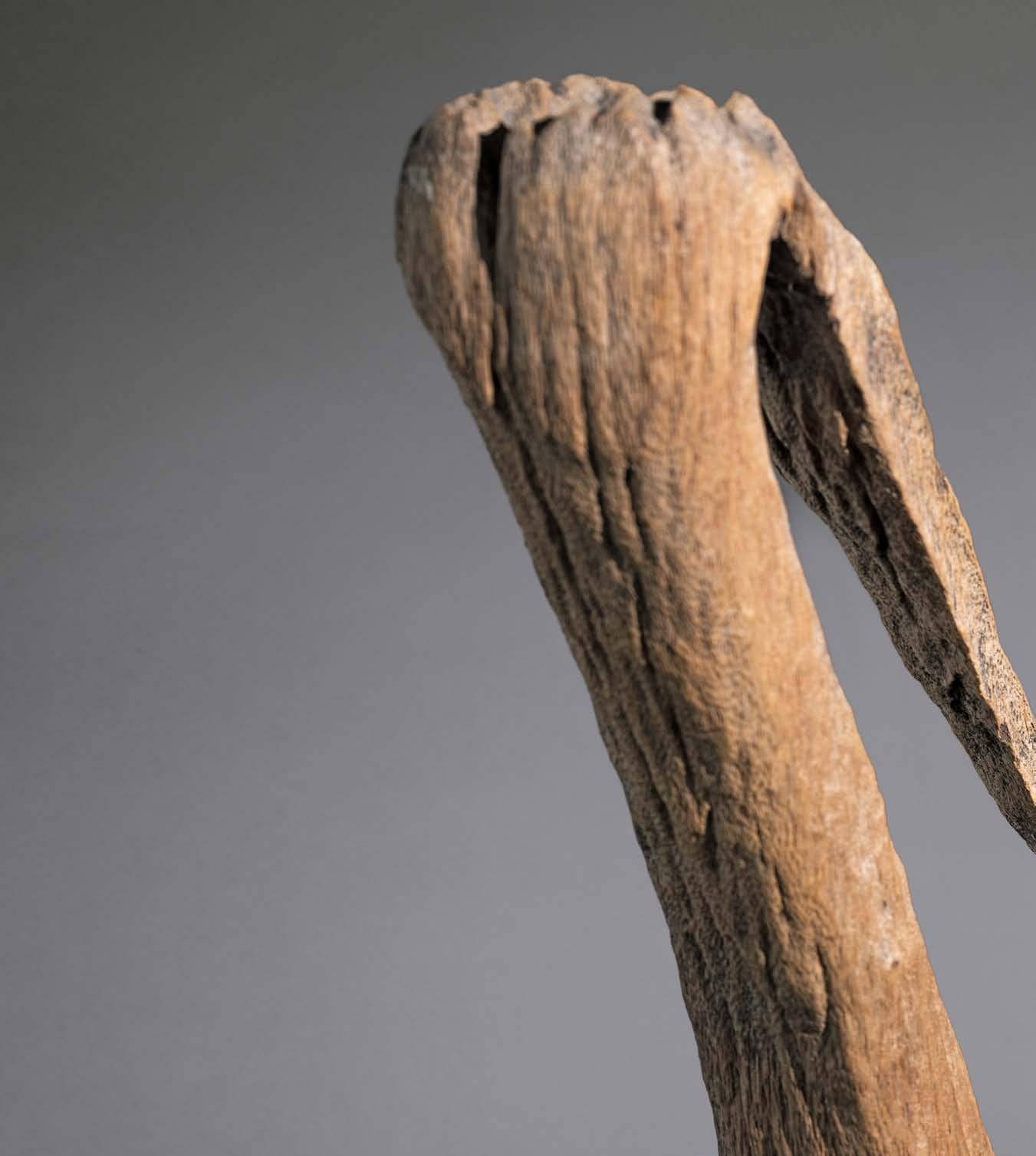
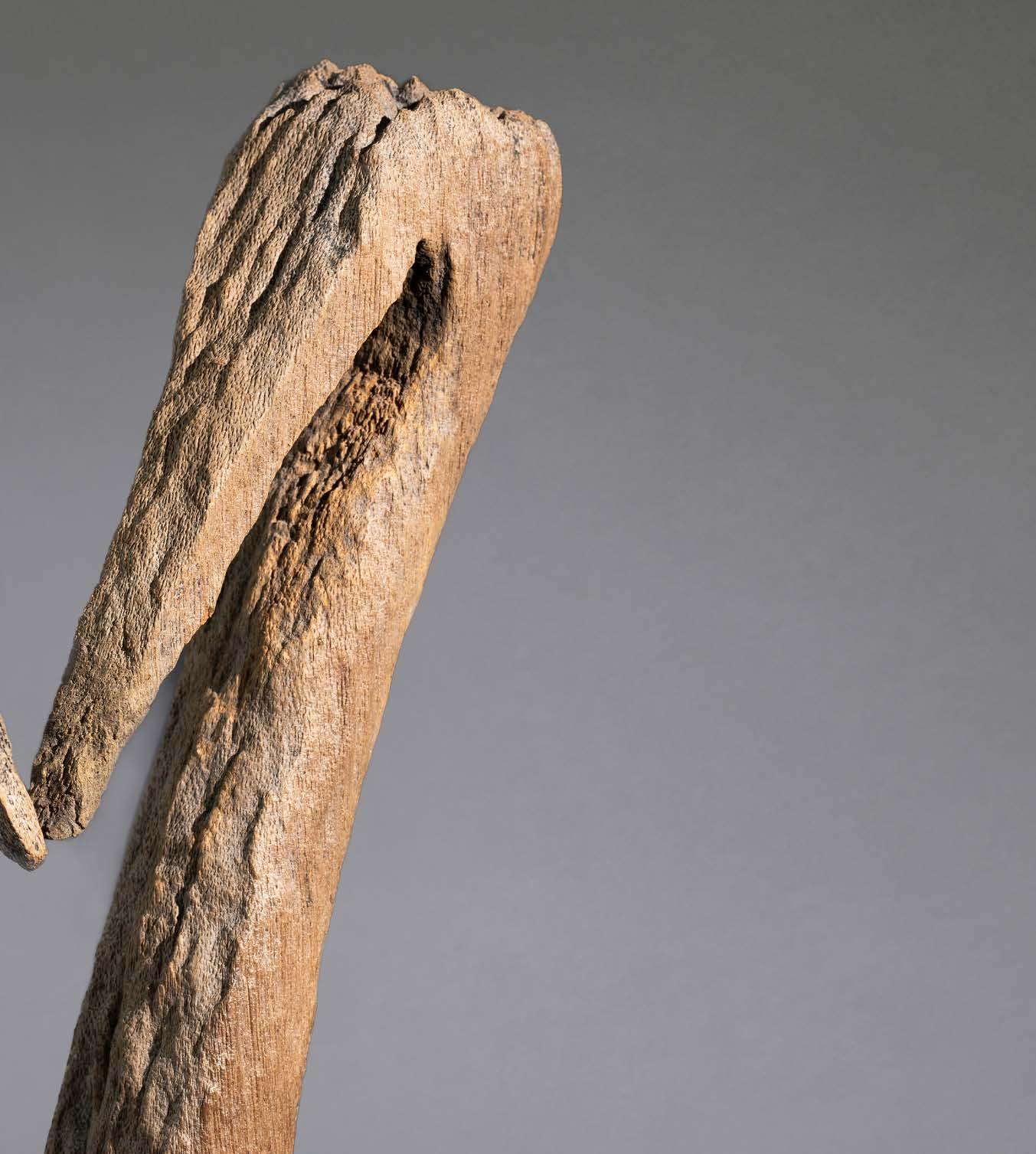
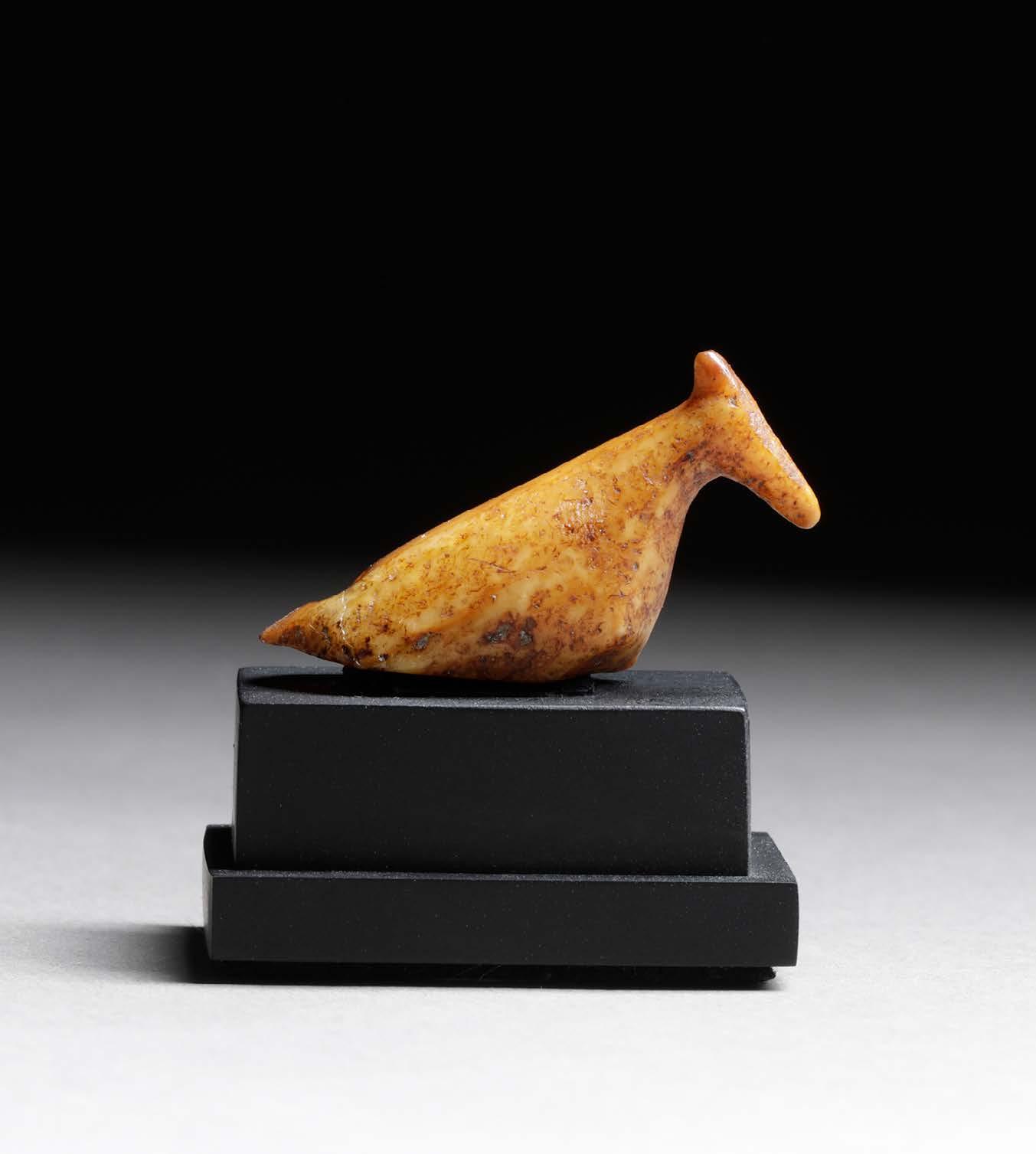
19th century
Walrus ivory
Height: 1 in; Width 1½ in
PROVENANCE
Seward Kennedy (1925–2015) New York and London
Among the many games played by the Inuit, there were two whose pieces required the skill of the carver. One was a version of the pin and cup game, called ayagak. Players would flip a dangling pin into the holes of a perforated object, which was sometimes made in the shape of a bear. The other was tingmiujang, meaning ‘images of birds.’ This was a game of chance similar to dice. A set of about fifteen game pieces in the shape of birds and human beings were shaken in the hands and thrown upward. Upon falling, those pieces that happened to stand upright would be taken by the player whom they faced. The players would take turns throwing until the last figure was claimed, the winner being the one with the greatest number of figures.
The present game piece, carved from walrus ivory, takes the form of an abstract bird in miniature, measuring just under one inch tall. Its triangular body, sweeping back from a stylized, featureless head, rests on a flat base that enabled the figure to stand upright for the purposes of the game. The ivory is mottled with age and smoothed with wear, suggesting this piece had a long history entertaining its owners. A hole is found at the tail of the figure, which may have allowed the many pieces of the set to be strung together and organized on a cord. Small chip to top of head and crack near tail.
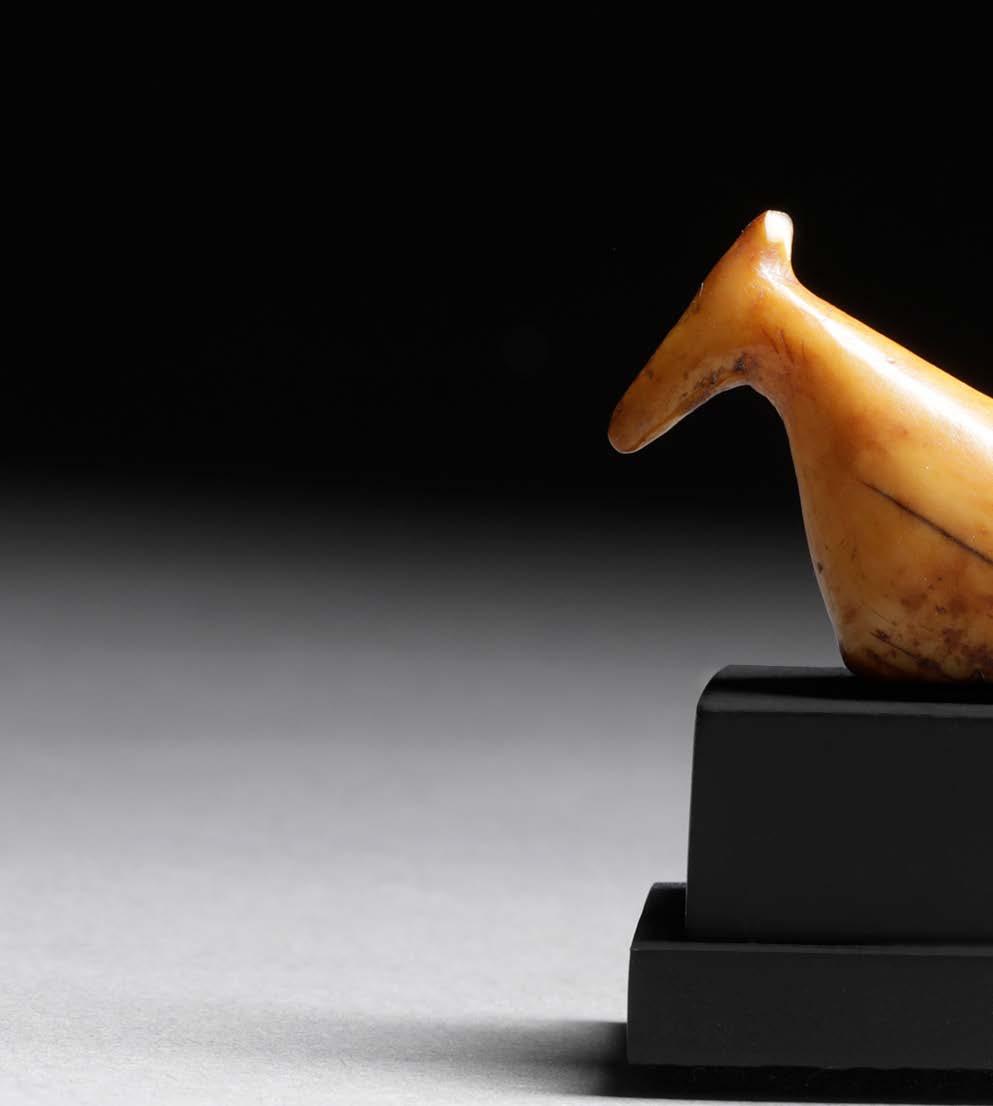
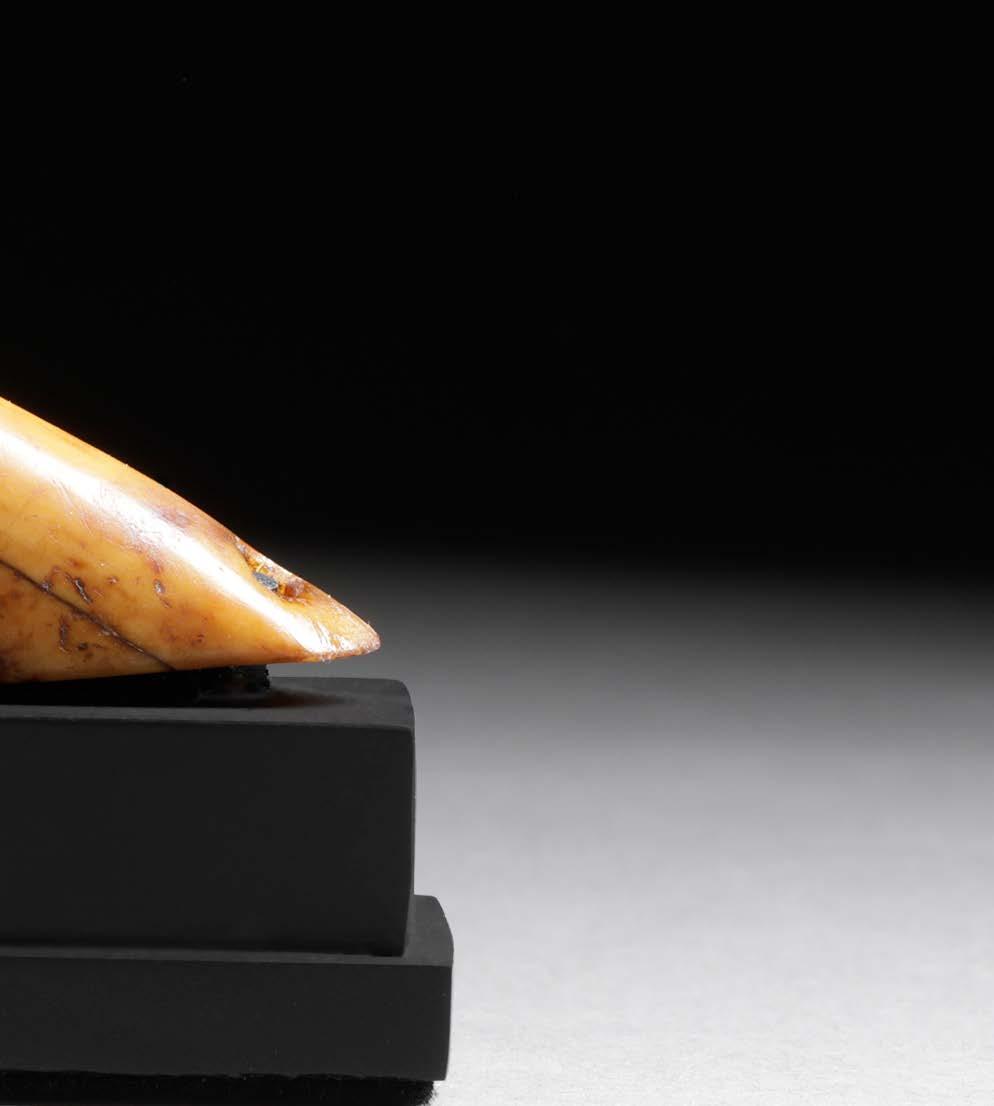
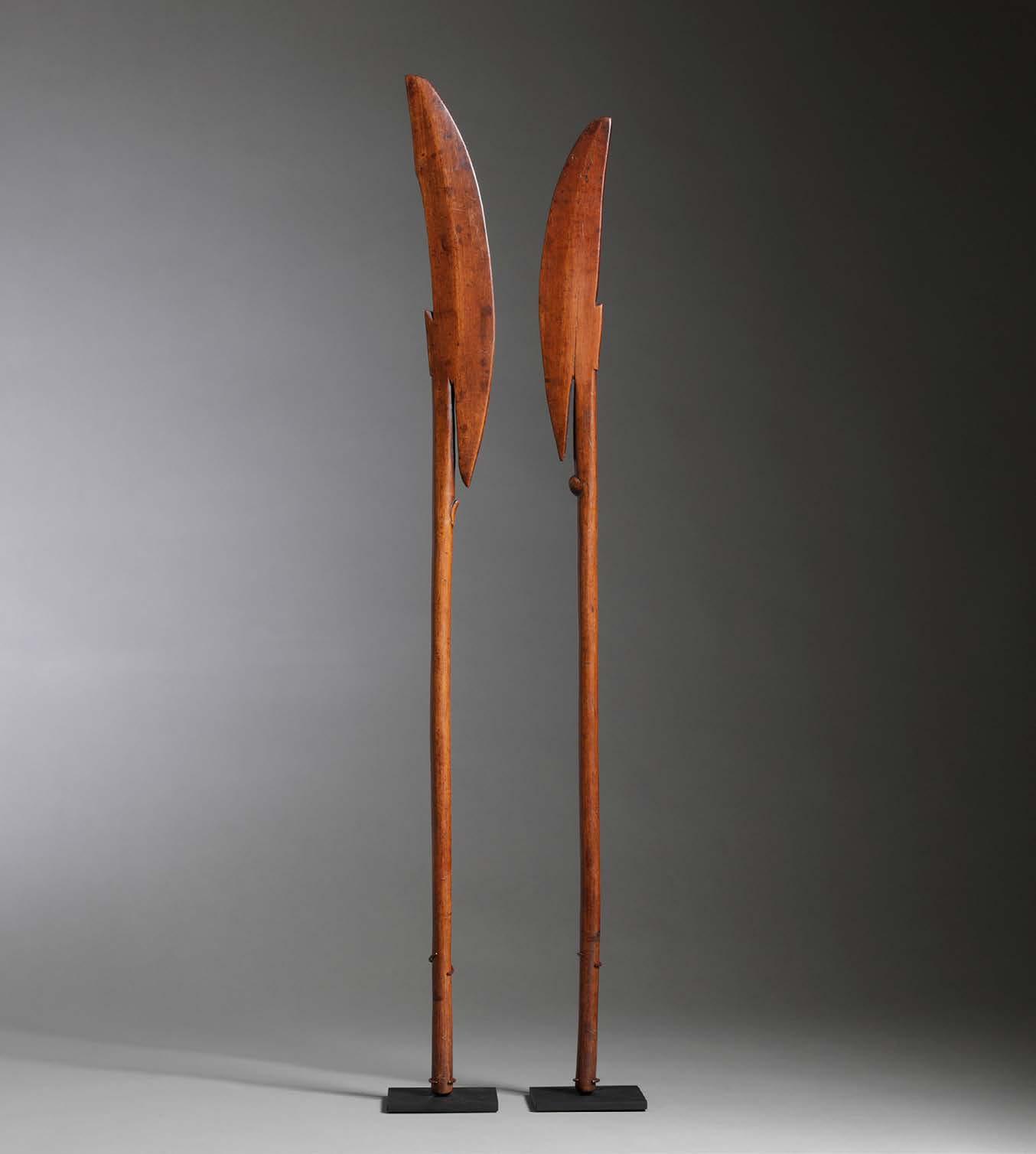
19th century
Wood
Height (of taller staff): 32 in
PROVENANCE
Max Itzikovitz, Paris
Merton Simpson Gallery, New York
The Amy & Elliot Lawrence Collection, New York, acquired January, 1985
PUBLICATION HISTORY
Merton Simpson Gallery, NY, September 1984, cat. no. 17.
These two ceremonial implements of nearly identical form, one larger than the other, are considered a male and female pair. Each staff is carved from a single piece of wood and features a crescent-shaped blade surmounting a shaft, in the manner of a glaive. One staff bears a rounded node detail just beneath the blade representing a female breast, and the other a concave, ovate support representing a phallus. Warm brown surfaces lend a handsome effect to these elegant and rare pieces of Nguni woodworking.
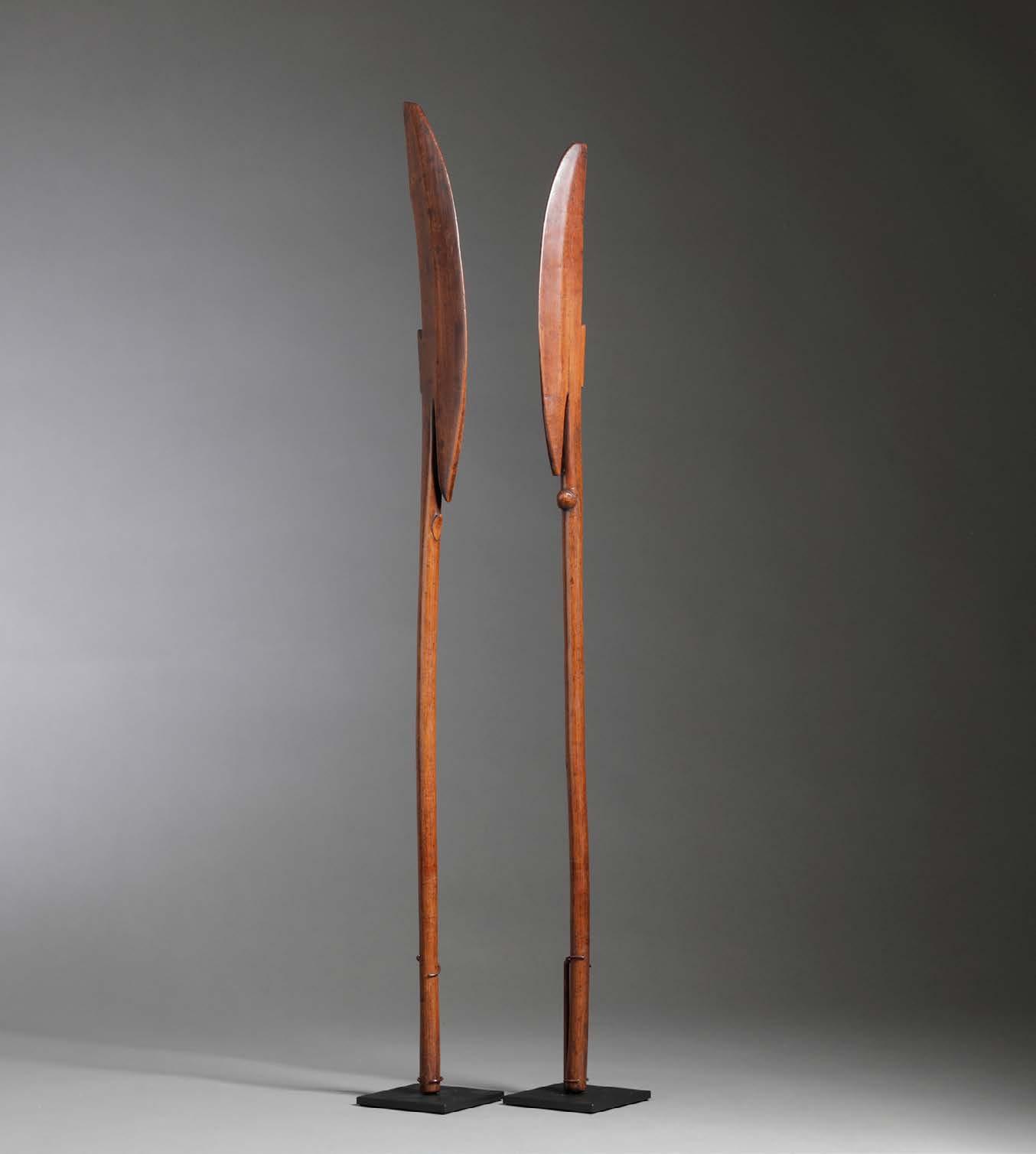
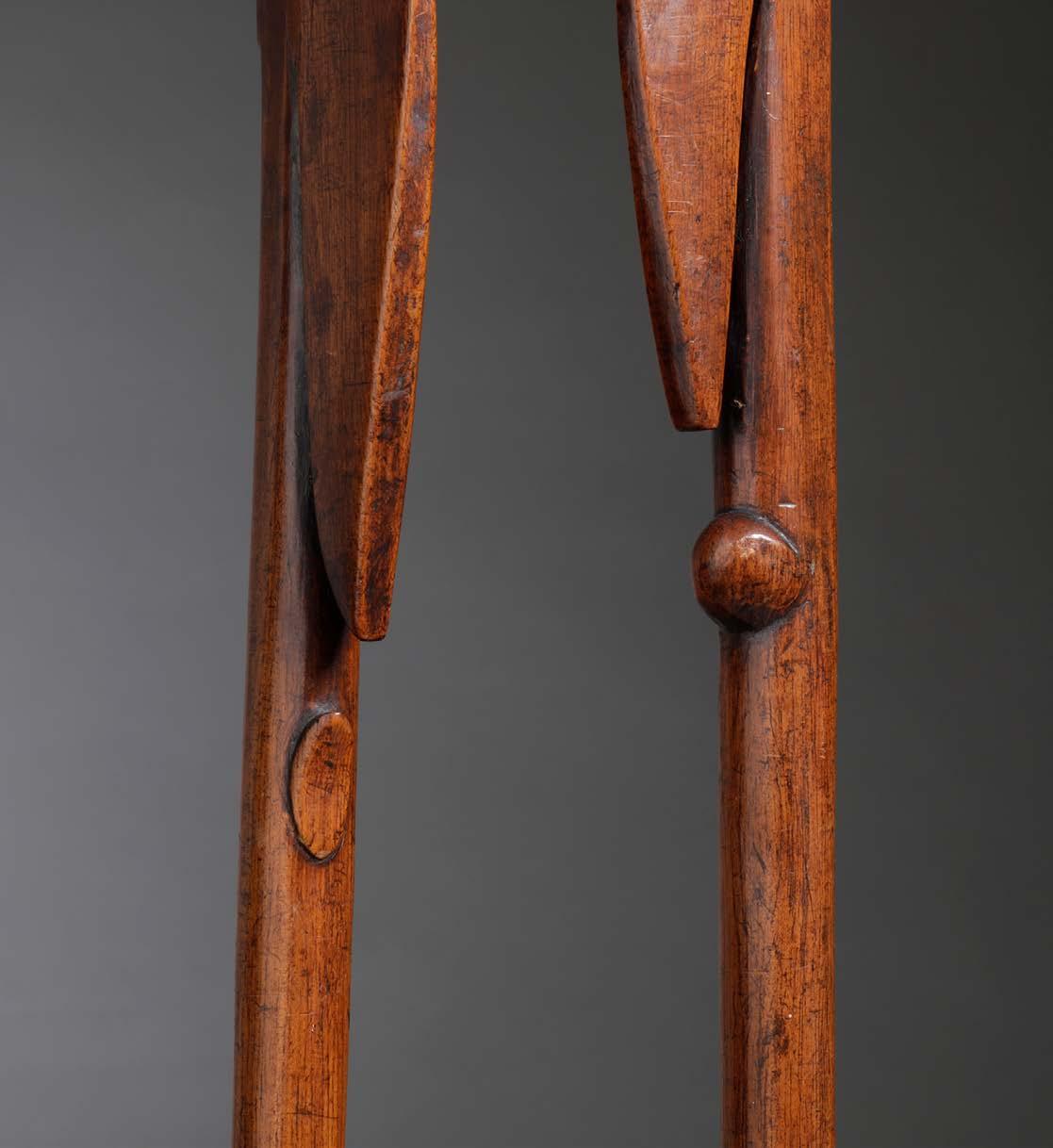
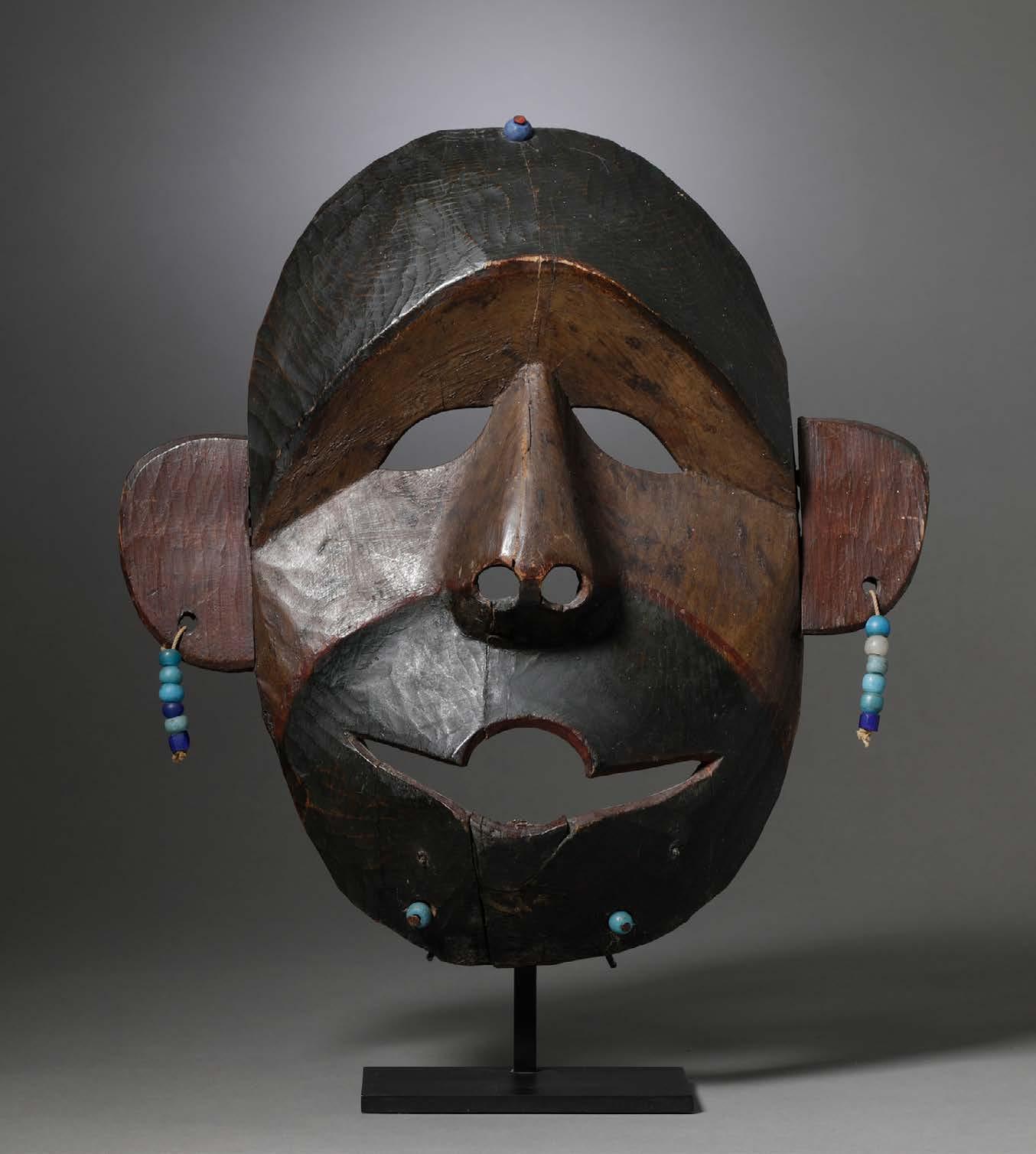
19th century
Wood, beads, pigments
Height: 11¾ in; Width 11 in
Possibly Walter Koerner (1888–1995) Collection
Sotheby’s Important American Indian Art December 2, 1998 Lot
475
Private Collection, USA
During long winters in the Arctic, Eskimo communities enjoyed feasts and performed masked dances in order to maintain harmony between the human, animal, and supernatural worlds. Masks were employed by a shaman (angalkuq), the only member of the community with sufficient power to control the spirits of nature. Masks enabled them to communicate with the spirits and understand their needs, and to give recommendations on how to appease them. Costumed dancers performed singly or in pairs, portraying a range of spirit beings and animal helpers. Humorous masks also appeared at times, including caricatures of local people meant to entertain the audience. In Yup’ik culture, masks are the result of the efforts of more than one person. The angalkuq, with their exclusive insight on the wishes of the spirits, explained to the carvers – who were women as well as men – how to make the masks. After the arrival of Christian evangelization in Yup’ik territory, mask traditions waned but were never entirely forgotten.
The mask offered here is of an anthropomorphic type, with a broad, theatrical character and vigorous composition that make an immediate impression on the viewer. The wide ears, sharply jutting brow ridge, steeply downturned eyes, and highly expressive nose and mouth give abundant personality to this mask. It is blackened over the extent of the forehead and around the mouth, bringing focus to the eyes. Blue beads are attached at each ear, at the top of the head, and at the chin. The unusual shape of the mouth is of special interest: with its combined circle-andcrescent design, the mask seems to hold two simultaneous expressions. For another example with similar treatment of the mouth, identified as a Kuskokwin walrus spirit mask, see Amez, Daniele (ed.). Masques Eskimo D’Alaska. Editions Amez, 1991, pg. 208.
Some vertical cracks to the mask as can be seen in the images. Small restoration to base of left nostril.

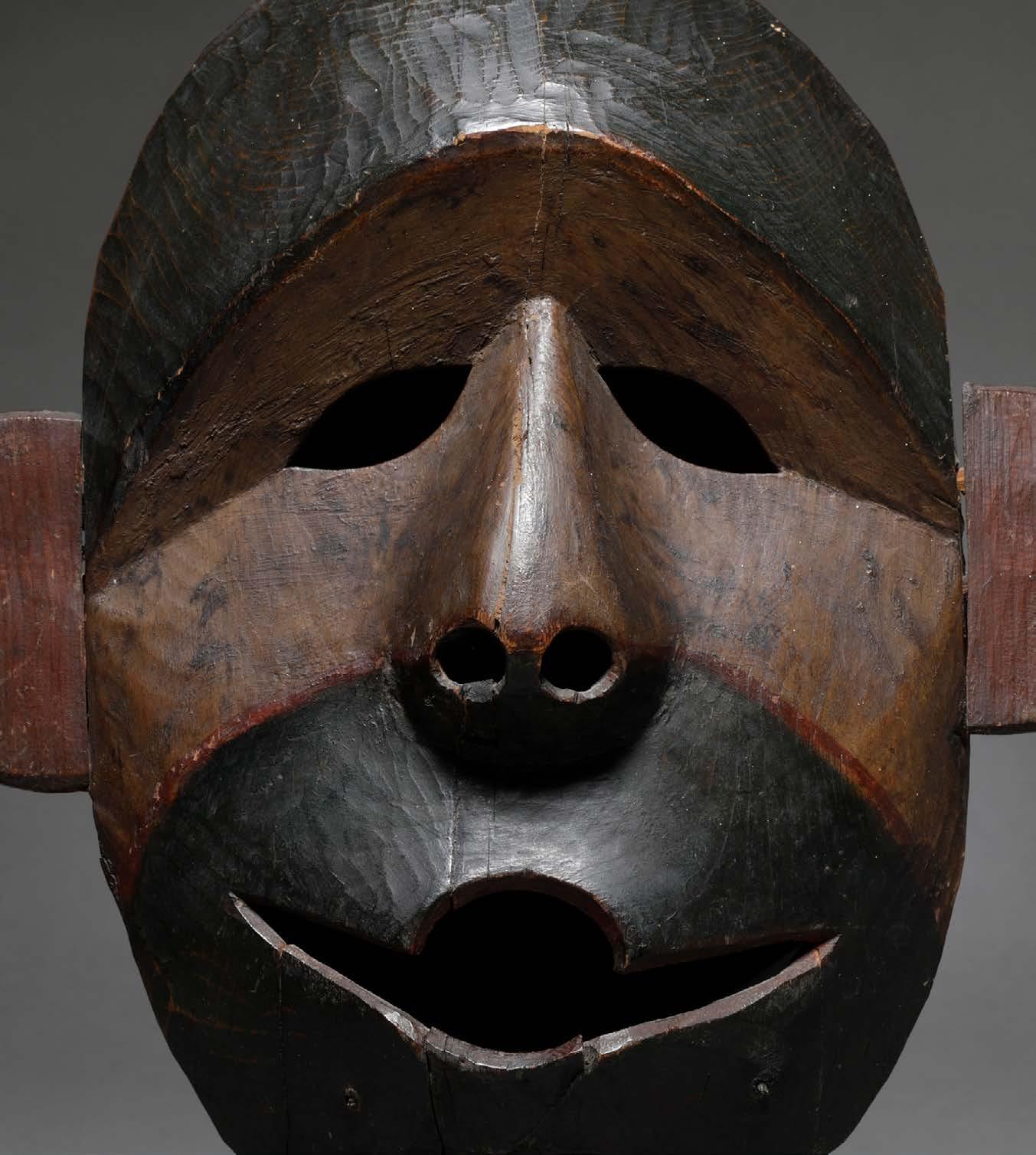
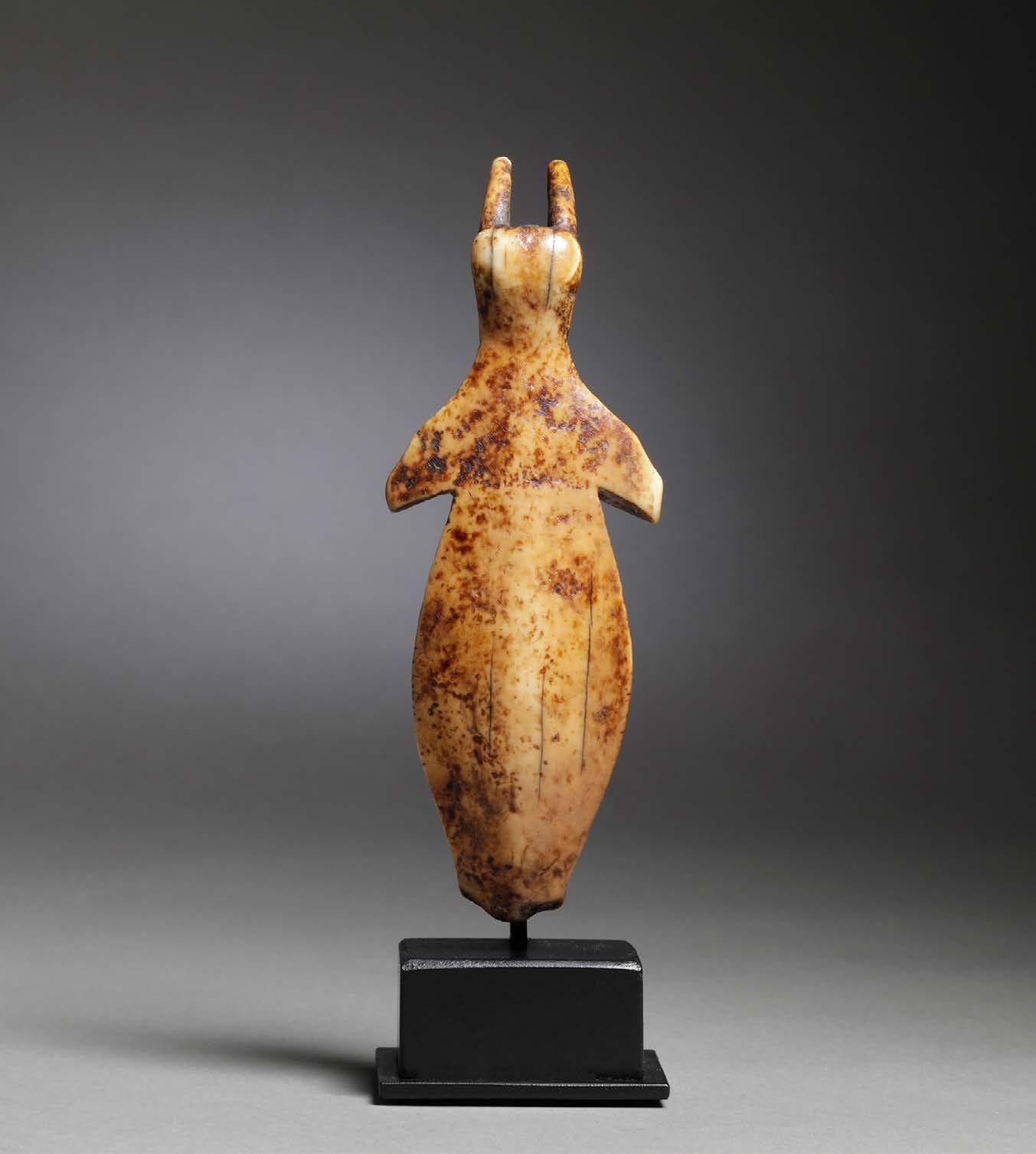
ca ad 1000–1600
Walrus ivory
Height: 5¾ in
Excavated on St. Lawrence Island in the 1990’s by Seppilu
Jeffrey Myers, New York
Private US collection since late 1990’s
An archetypal image which was carved from the tusk of the subject itself, this walrus effigy was probably used as a protective or propitiatory amulet by a hunter. The floating, symmetrical pose of its age-spotted form almost seems to suggest the appearance of an abstract human figure, evoking an impression of dreamlike transformation.
Animal spirits were of great importance to Arctic peoples, whose lives depended upon animals surrendering their own. This was a profound relationship of sacrifice and trust that the hunter was loath to betray. Charm images such as this were created and carried to help guide the hunter and to call the animal to him in the proper way, ensuring the continuance of their metaphysical bond. Amulets could also confer certain characteristics and abilities of an animal to its bearer, and figurines were often sewn into clothing or attached to a belt so that the wearer could remain under their influence at all times.
With the introduction of Christianity to Alaska in the eighteenth and nineteenth centuries, amulets became symbols of unsanctified spiritual interaction. Branded with social stigma, they gradually fell out of favor among Arctic peoples and disappeared from common use. While detailed knowledge regarding traditions of amulet use has since been lost, the practice continues on a smaller scale in certain regions of the Arctic, sheltered from public knowledge.
For an almost identical example, complete with flippers, in the Rock Foundation Collection, and almost certainly by the same hand, see Upside Down: Arctic Realities Fig 18 p. 105 by Edmund Carpenter et al. The Rock Foundation example was exhibited at Upside Down Arctic Realities (The Menil Collection, Houston, Texas, April – July 2011)
And Upside Down: Les Artiques (Musee Du Quai Branly, Paris, France, September 2008 – January 2009). In good condition, flippers are no longer extant.
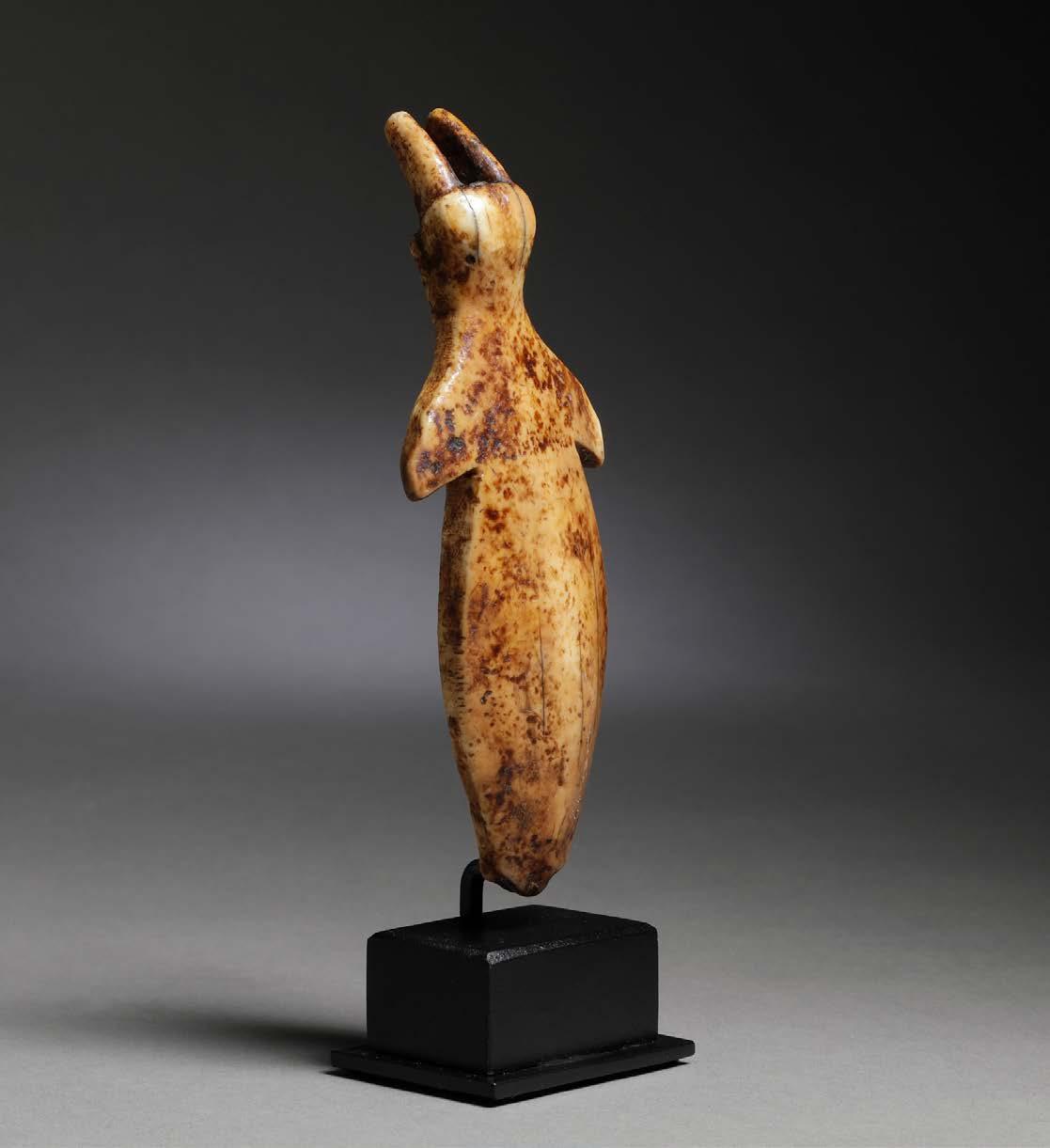

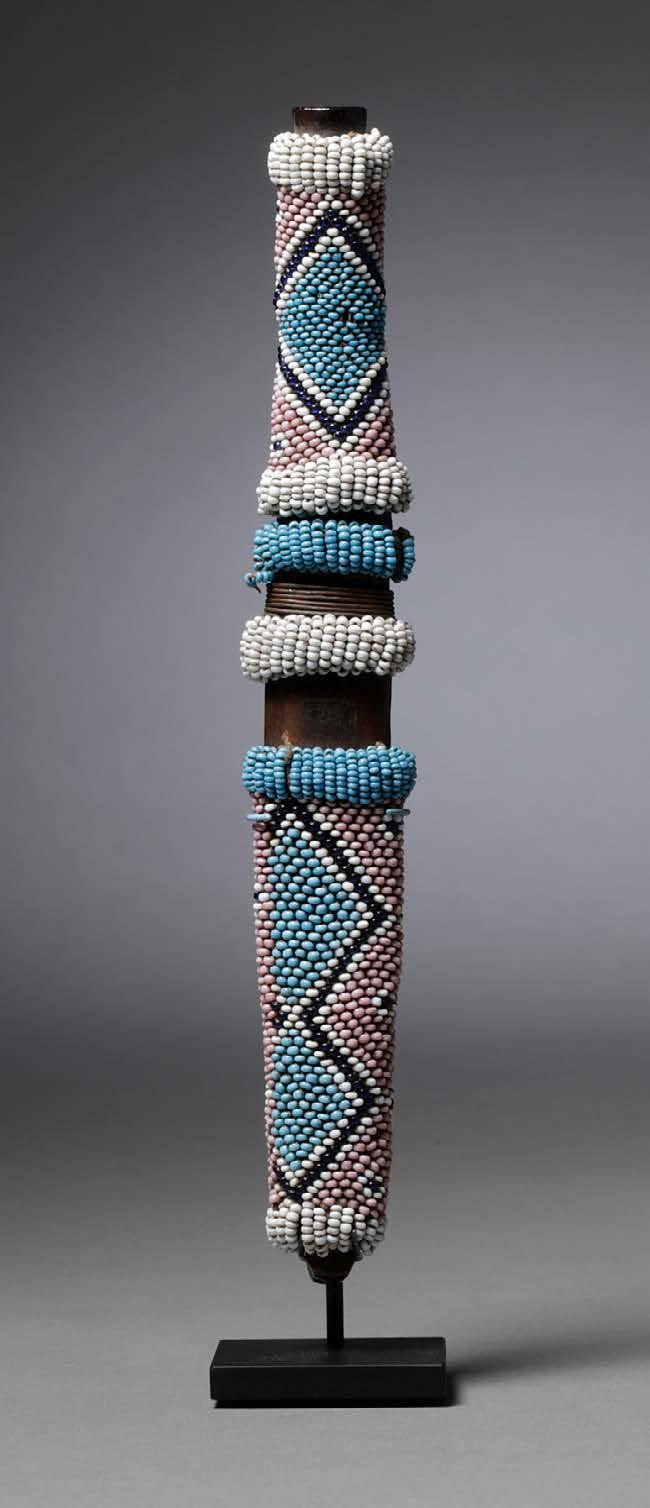

Late 19th century Wood, metal, glass beads, sinew Height: 8½ in
PROVENANCE
Private collection, UK
Private collection, South Africa
A handsome Ngoni dagger with an elongated, tapered point and wooden handle and sheath, clothed entirely in a mesh of well-preserved beadwork. The soft color scheme of pink, blue, and white, accented with black details, is a familiar design choice in this region of southern Africa. Bladed weapons are less commonly found among the territories of the Ngoni and their neighbors, where wooden weapons such as the ubiquitous knobkerrie predominated. This knife would have been worn as part of a vivid ensemble of other beaded pieces and accessories, carried for adornment as much as for utility. There is a small area of bead loss around the midsection of the knife.

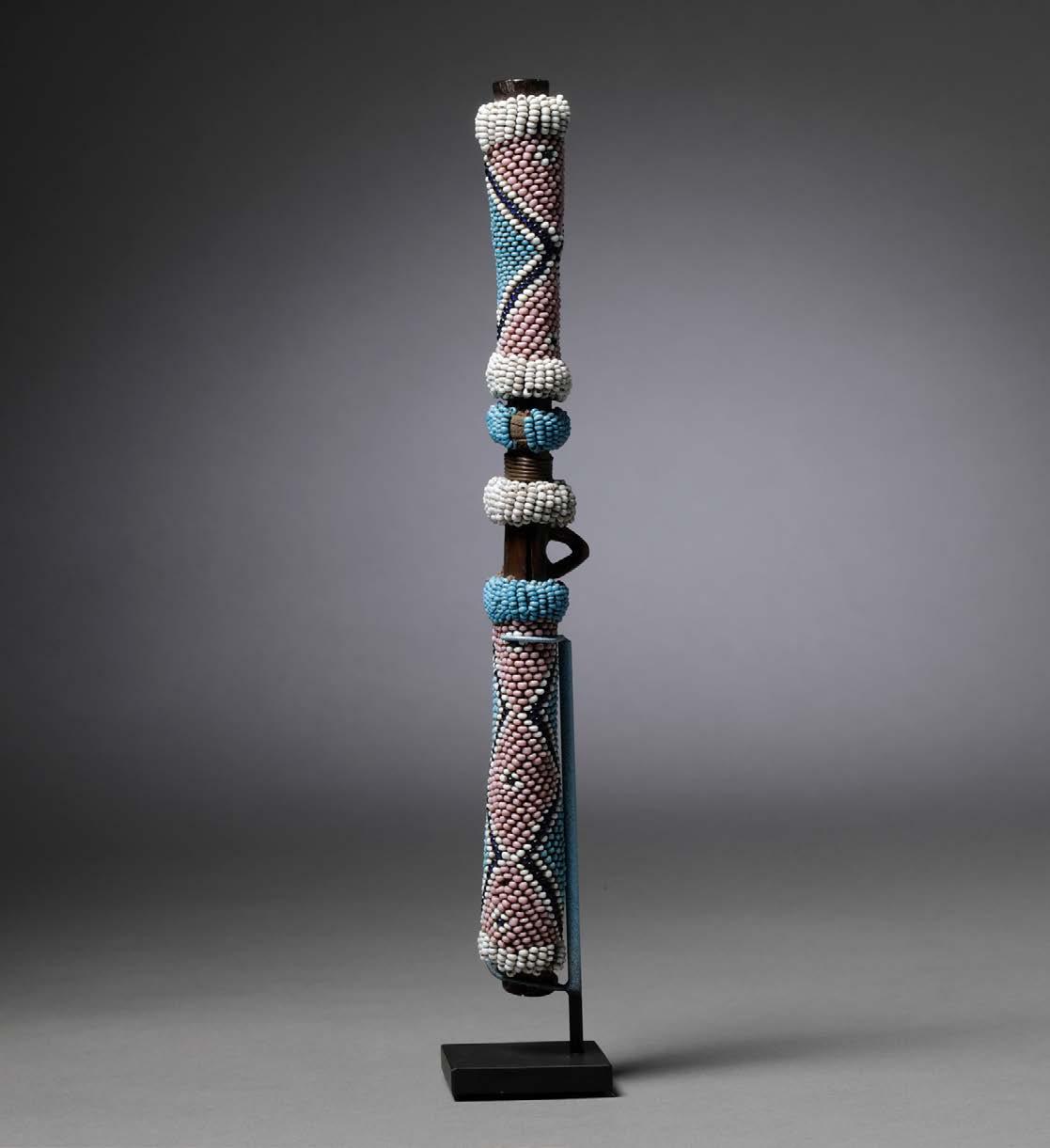
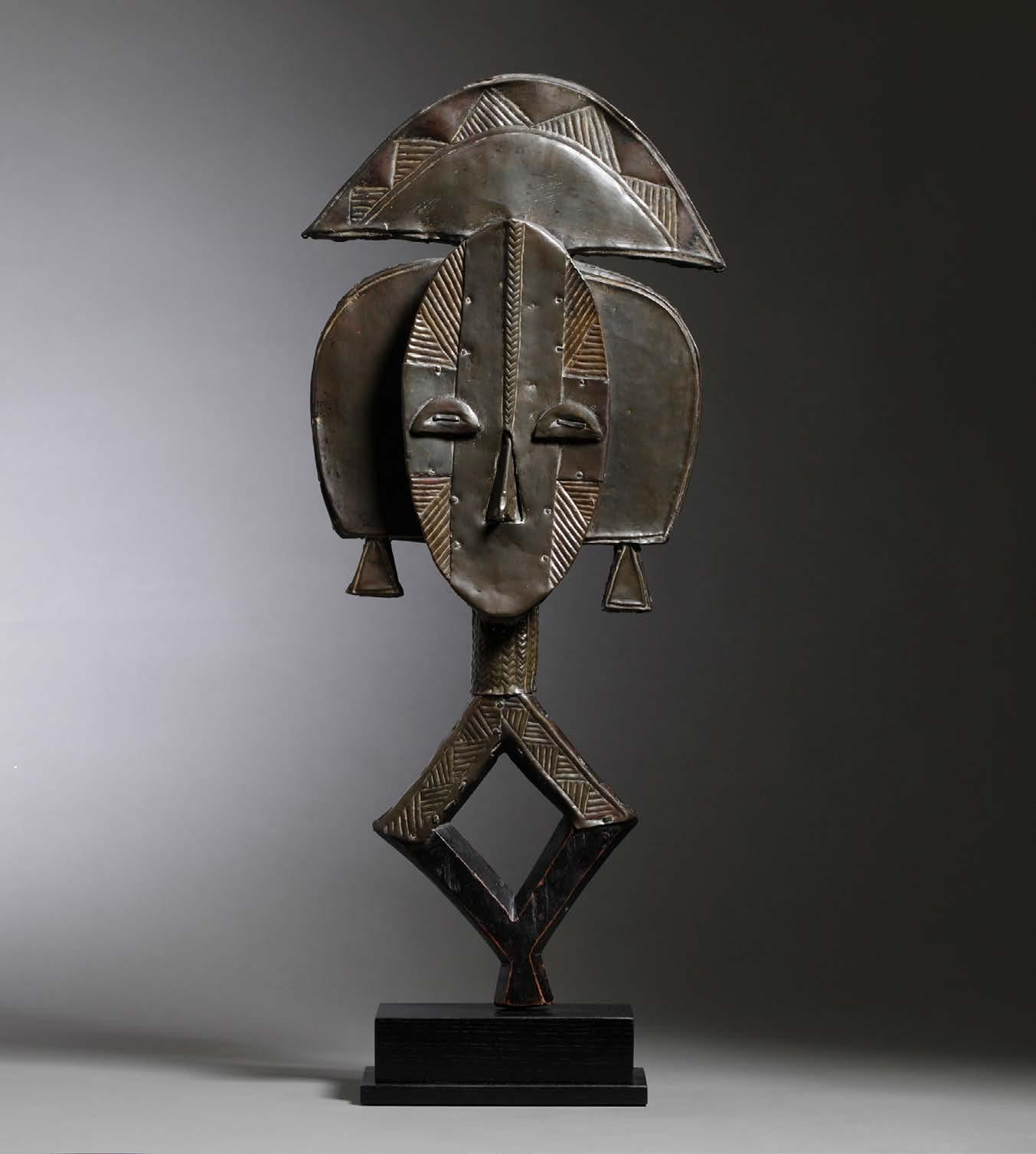
Late 19th / early 20th century
Wood, copper alloy
Height: 26 in
Claude Bentley (1925–1990), Chicago, IL. Bentley was a painter, lithographer, muralist, teacher and collector born in New York City in 1915. He primarily lived and worked in Chicago. After studying at Northwestern University and the Art Institute of Chicago, he returned as a professor to teach at the Art Institute. From 1941 to 1945, Bentley served in North Africa with the armed forces and in France. His time there sparked an interest in African, Oceanic, and pre-Columbian art, of which he became an avid collector. These fascinations informed his geometric style, and gave a tribal feel to his Abstract Expressionist art.
Arcade Gallery, London. July, 1978
Sir Gerhard Jacob ‘Jack’ Zunz (1923–2018), London, UK. Zunz was a British civil engineer and former chairman of Ove Arup & Partners. He was the principal structural designer of the Sydney Opera House. Zunz was born to a Jewish family in Mönchengladbach, Germany, but at the age of 13 he moved to South Africa. After interrupting his studies to serve with the South African Army in Egypt and Italy in the Second World War, he graduated in civil engineering at the University of the Witwatersrand, Johannesburg in 1948. He came to London to join Ove Arup in 1950. He was Chairman of the Arup group, from 1984 to 1989.
Until the middle of the twentieth century, clans across equatorial Africa preserved the memories and spirits of revered ancestors through reliquaries that held the skulls of the renowned and distinguished. Elders of the widespread ancestor cult (most widely known as bwiti or bwete among Kota peoples in areas now belonging to Gabon and the Republic of Congo) commissioned the creation of abstract figural sculptures (mbulu ngulu) to stand atop baskets or bark containers that housed these precious relics. Produced in a variety of styles, they were affixed to the lid of the reliquary container or lashed to a relic bundle placed inside. On a superficial level they acted as the public face of familial altars, but they served a much more complex and important role as agents of ancestral power in communal rites and ritual performances, channeling support and protection to the community.
This reliquary figure shows classic characteristics of the tradition, with full, sweeping forms and a majestic presence. The wide and curving shapes of its metal surfaces are balanced gracefully by sharp angles and rectilinear elements, all cohering in a geometric symmetry. The central face plate features semicircular eyes which suggest a benevolent aspect, and it is backed by a headdress of lobed and semicircular forms. Below, the neck terminates in an open, diamond-shaped structure. Hand-worked hatching is engraved into the face, crown, and neck. The copper bands and sheets applied to the wooden body of the figure were rare materials in the artist’s time, acquired through trade with Europeans and prized for their luster.
Beginning in the 1870s, Kota reliquary figures were among the earliest African sculptures to be acquired by European naturalists and explorers, among them Paul Du Chaillu, Alfred Marche, Oscar Lenz, and Pierre Savorgnan de Brazza. There are remains of an old label on the back of the reliquary, hand-written in French, describing its use. Old Bentley collection number of back of piece.
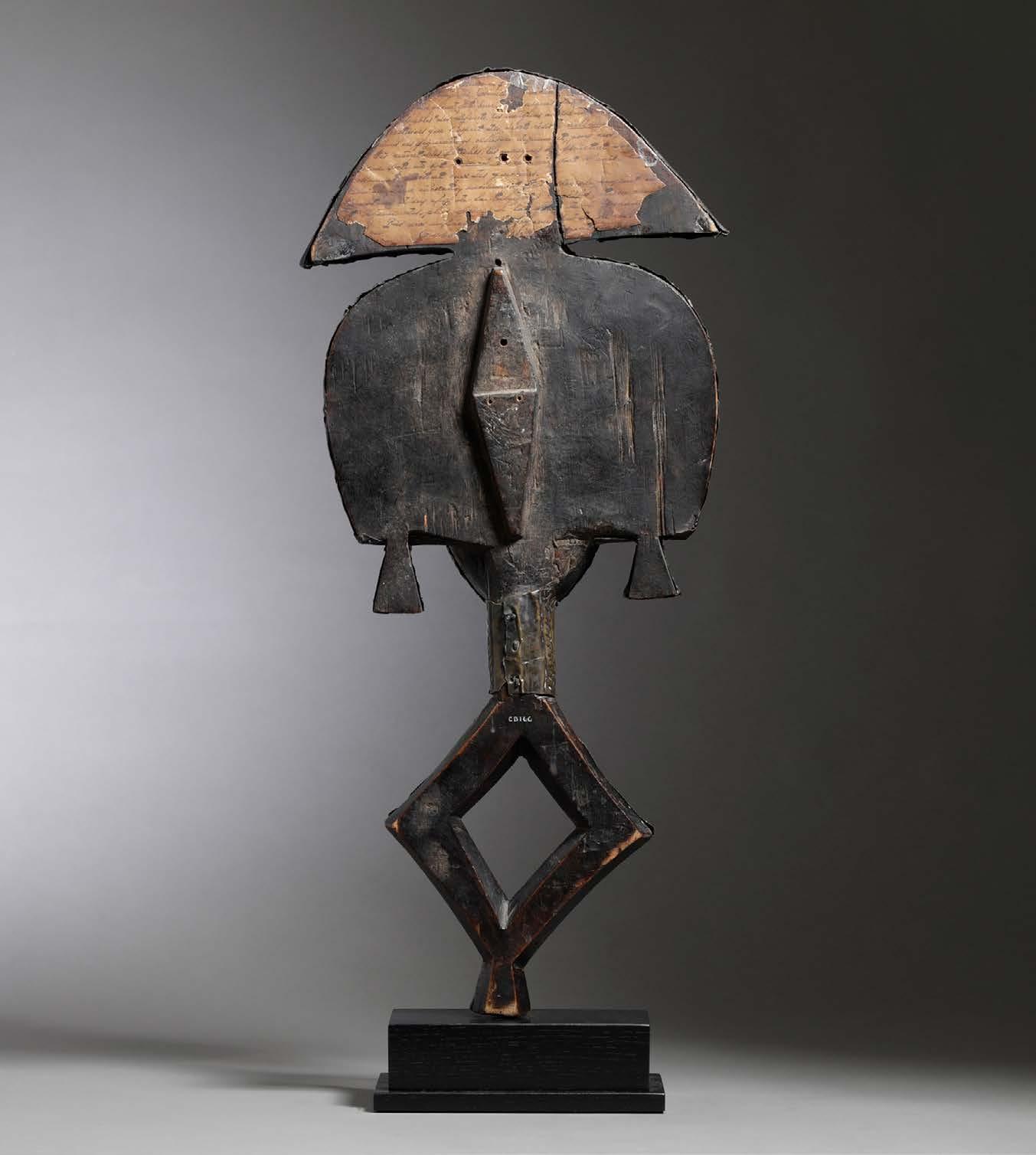
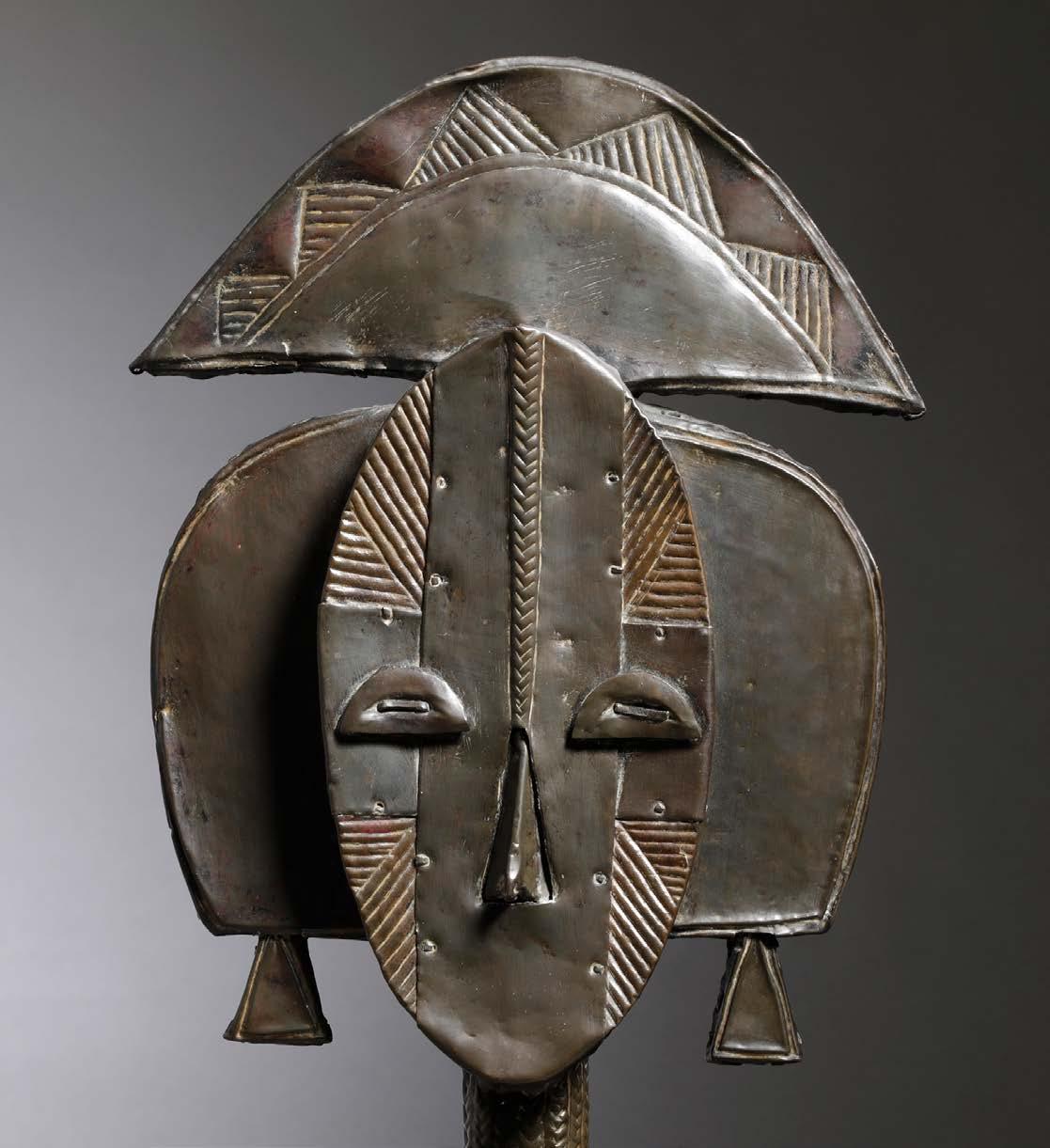


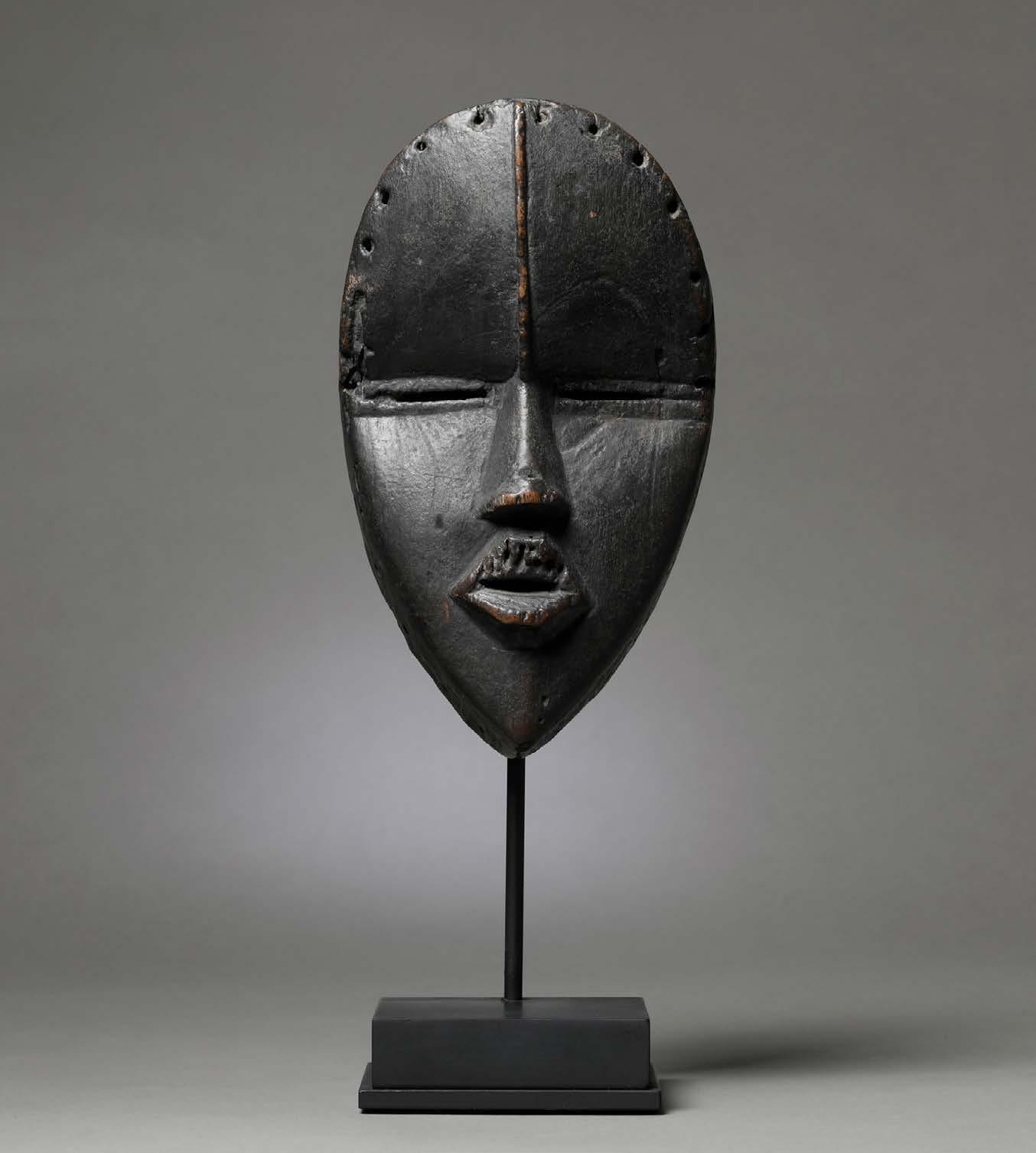
Late 19th / early 20th century
Wood
Height: 9 in; Width 5 in
Karob Collection, Boston, MA
Dan masks are embodiments of gle or ge, spirits who wish to communicate with and aid human communities but who lack a physical form. Materialized in dream-inspired masks, they attain their desires through the medium of masquerade. The mask presented here is of an iconic type referred to as dean gle. It is host to a benevolent spirit that seeks to teach and nurture, supporting peaceful activities in the village. Dean gle is technically genderless, though its qualities of idealized beauty and gracious beneficence are often thought of as feminine by both the Dan and outsiders.
This example demonstrates the classic dean gle composition, with an oval face tapering down to a narrow chin, slit eyes horizontally bisecting the face within a lateral depression, and a slightly open mouth with full lips. A vertical ridge in the center of the brow reflects a historical tattoo practice among the Liberian Dan. Around the perimeter of the forehead are pierced a row of holes by which a coiffure of fiber or shells would have been affixed. Some loss to the rear right side of the mask. Small repair to left eye.
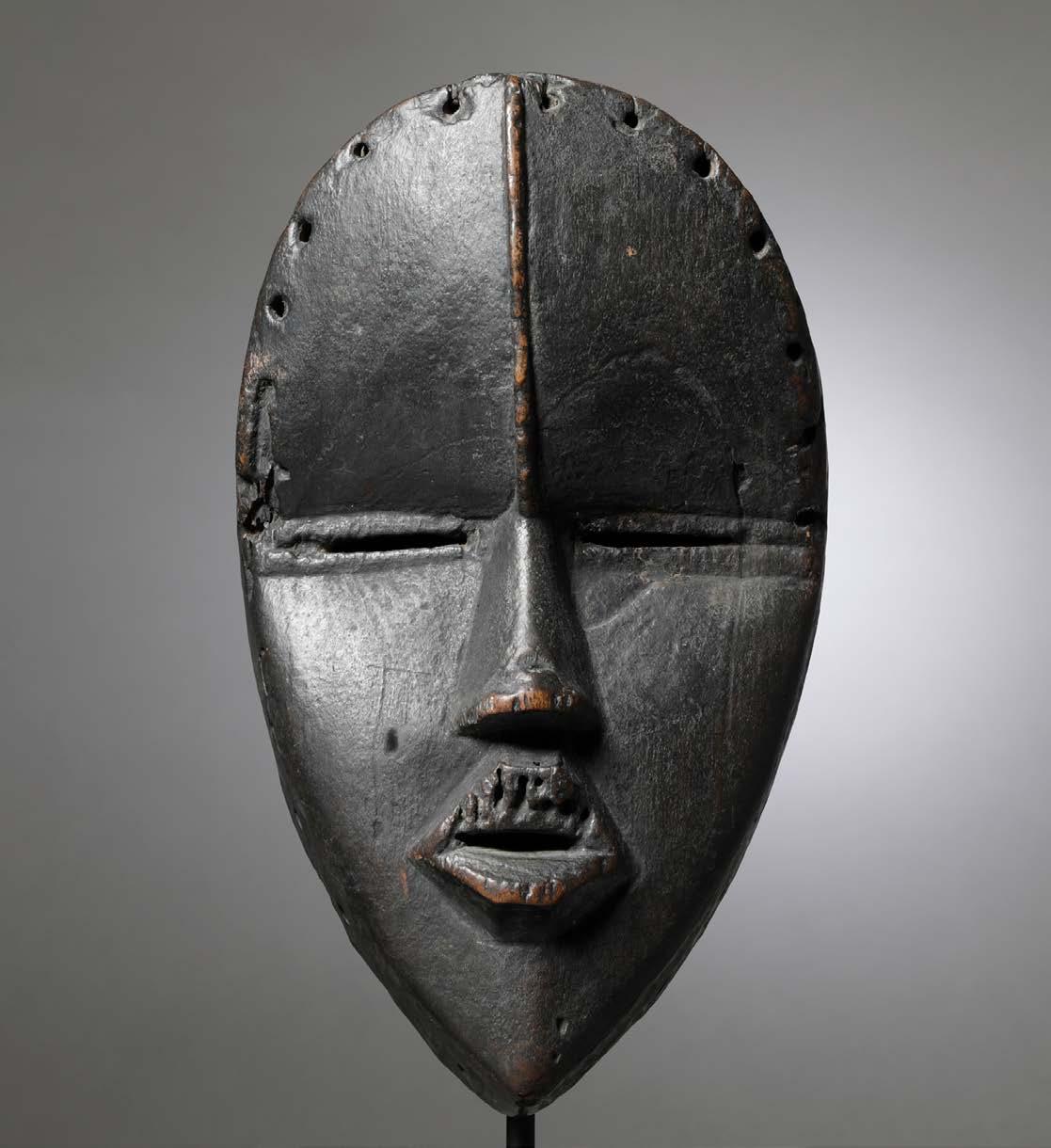
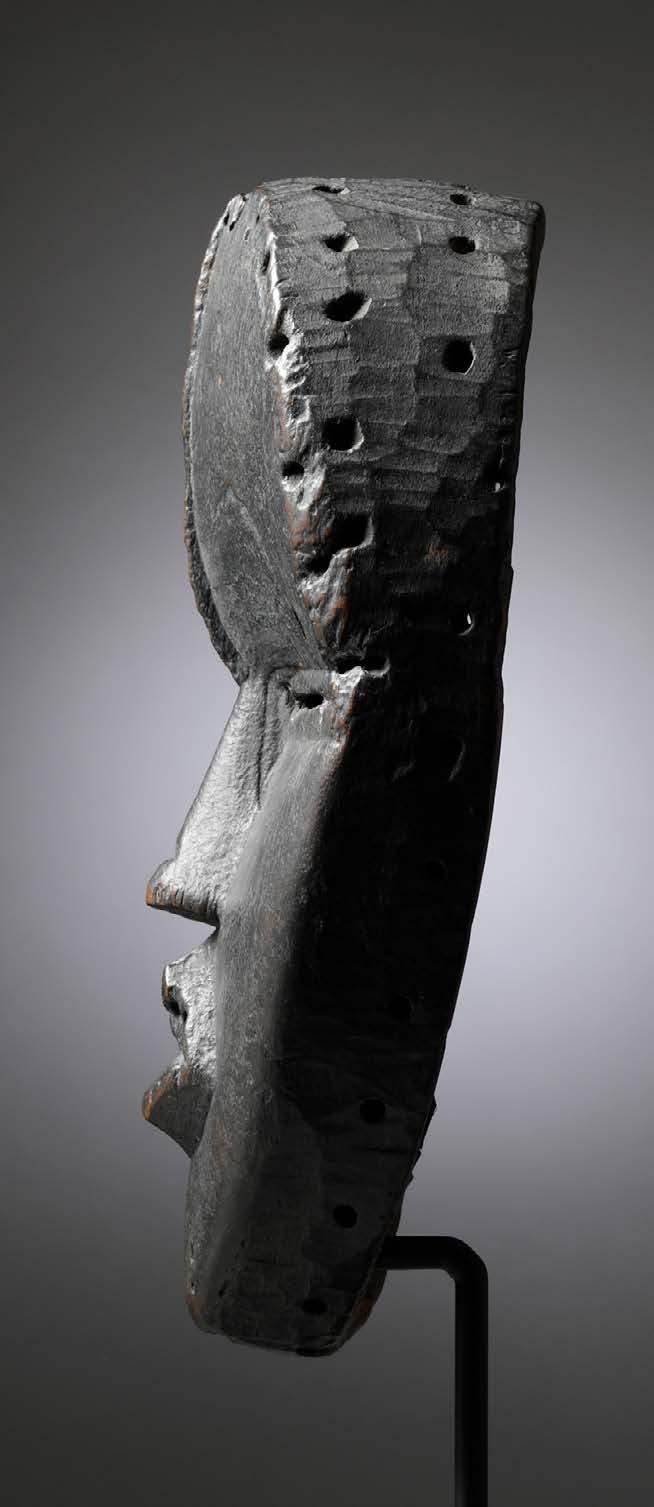


Late 19th / early 20th century
Wood
Height: 9 ½ in; Width 5 in
PROVENANCE
Karob Collection, Boston, MA
Bassa communities incorporate a number of female and male societies with rich masking traditions. Among these are Chu-Den-Zo and No, both of which utilize a type of mask known as gela, or geh-naw. This mask figures in dances held during celebratory events, such as the arrival of distinguished guests or the return of newly initiated boys from bush camp. In No performances, the gela emphasizes the feminine and graceful movements of the dancer, helping to illustrate desirable qualities which women are expected to possess. The gela is typically attached to a woven framework that projects outward from the forehead of the performer, and draped fabric hangs from the perimeter of the mask to conceal their head and shoulders. As a result of this design, the interiors of gela masks rarely show significant wear.
The artistic influence of the neighboring Dan people is clearly seen in this fine gela, with its swelling brow, tapered face, slit eyes, and deep concavity. A coiffure of nine heavy ridges, accompanied by a number of additional protrusions, adds a profound sense of mass that magnifies the weight of the brow and amplifies the aura of the mask. A hatched vertical band traces down the center of the face and the prominent nose, across the mouth to the tip of the pointed chin. Erosion and an encrusted patina lend further textural richness to this highly physical piece of Bassa carving.
Some areas of erosion on the front of the mask as seen in images. Some loss to top lip. Three of the forehead plugs are missing.
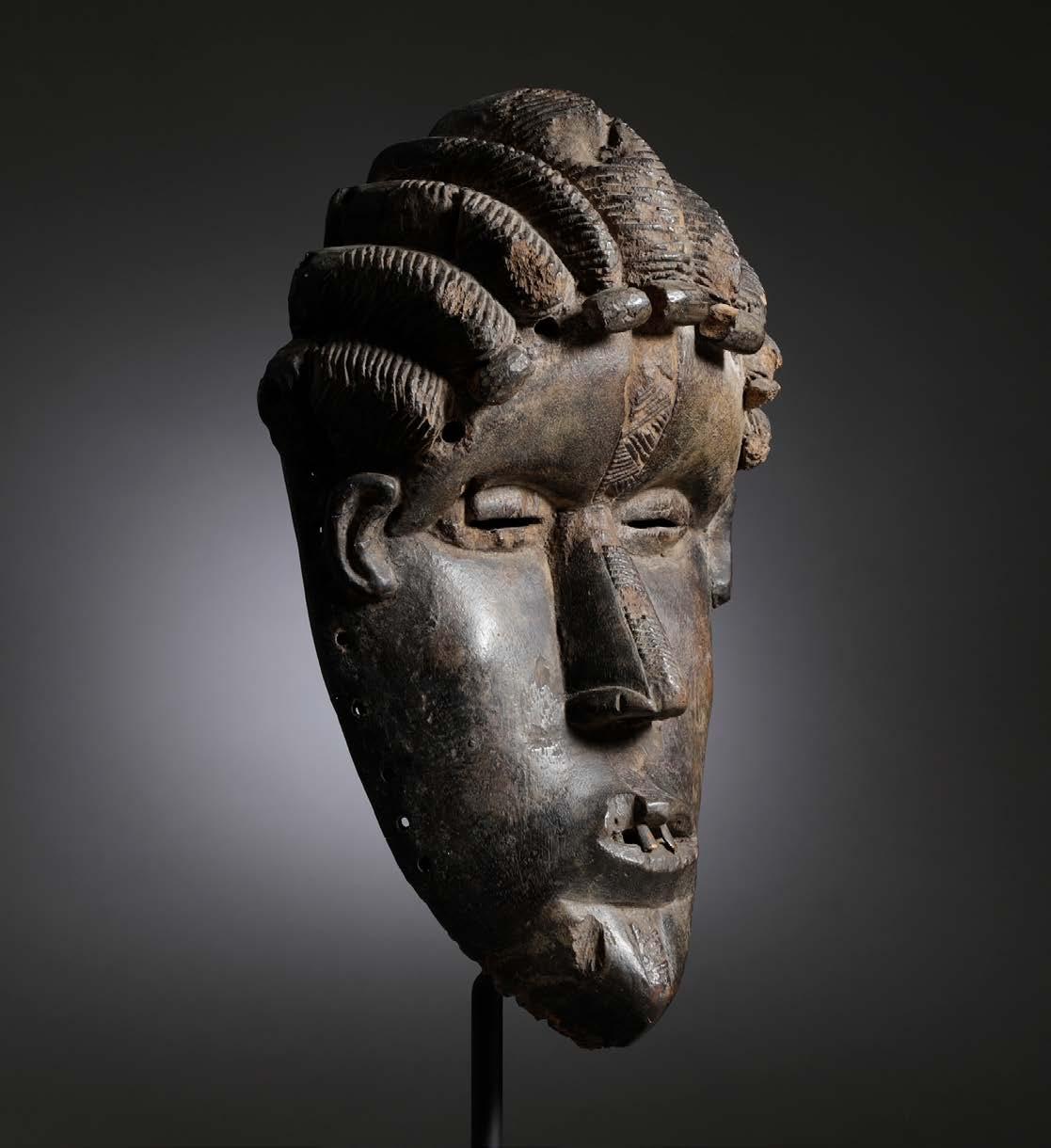


Late 19th / early 20th century
Wood
Height: 8 ¼ in
PROVENANCE
The Donald Morris Gallery, Detroit, IL, USA, 1978. Karob Collection, Boston, MA
PUBLICATION HISTORY
‘Designs for Living’ by Adams (Monni), Peabody Museum of Archaeology and Ethnology, The Carpenter Center for the Visual Arts, Harvard University Cambridge, 1982: #74
EXHIBITION HISTORY
Cambridge, MA, USA: Designs for Living, Peabody Museum of Archaeology and Ethnology, The Carpenter Center for the Visual Arts, Harvard University Cambridge, 2 November-20 December
1982
When a Lulua woman lost a child or had difficulties in childbearing that were beyond the power of a diviner to resolve, she would be initiated into a fertility cult known as bwanga bwa cibola. The cult’s practices called upon ancestor spirits to intercede on behalf of the mother and ensure her success in bringing a child to term. A ritual figure called mbulenga would be carved and placed in the home as a
repository and conduit for prayer. These figures are among the most iconic in the Lulua corpus, and the finest examples are renowned for their sculptural power and refined workmanship.
The characteristics of the present figure follow the canonical template for mbulenga: an oversized head with large vertical horn, a serene and confident expression, a long neck, and short, compact, bent legs. A cup is held in the figure’s left hand next to the belly, from which a prominent umbilicus protrudes. Mbulenga are often adorned with extensive relief designs covering the body, which represent scarifications. Some are visible here despite the encrusted layers of ritual material remaining on the neck and torso, including some of the concentric circles that surround the navel, which symbolize life.


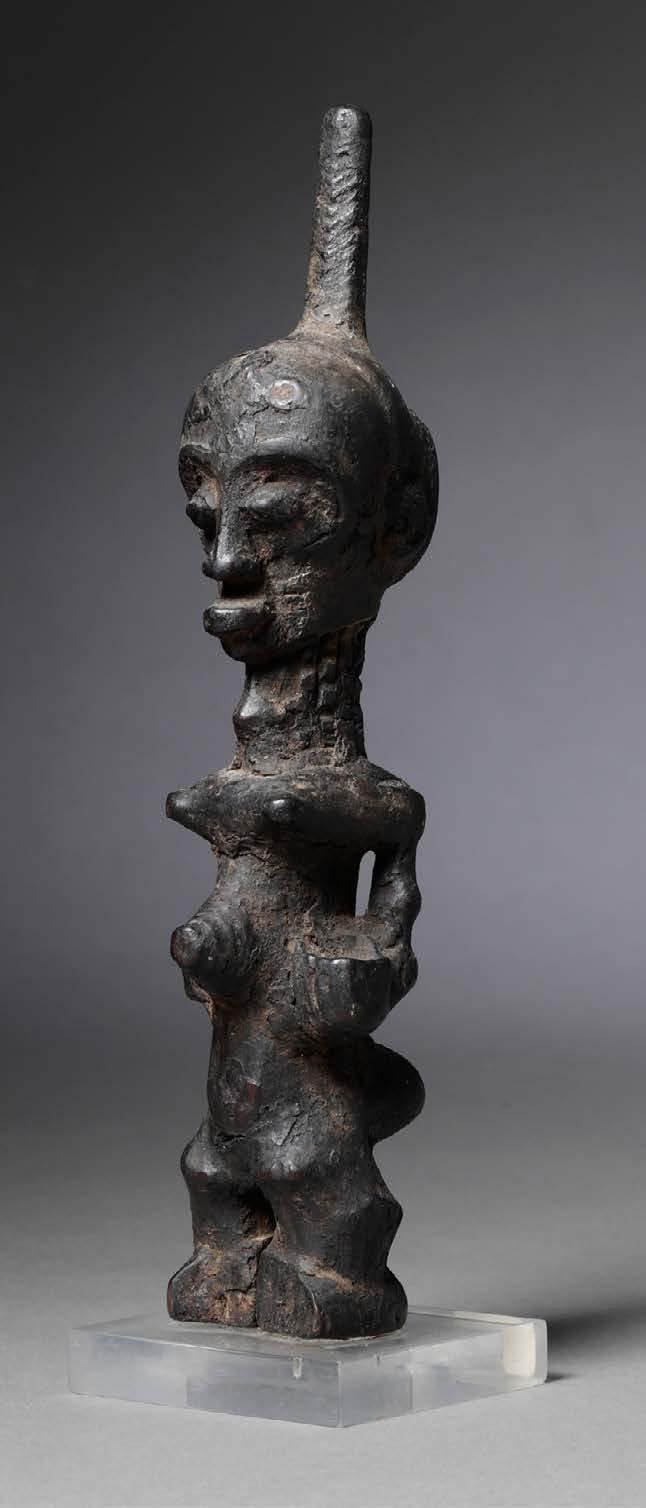

Late 19th / early 20th century
Wood
Height: 14 in
PROVENANCE
Private collection, France
Dalton-Somaré Gallery, Italy
Private collection, USA
The impressive statuary of the Baule embodies varied incorporeal energies that are granted form and appeasement through the physical form of a wooden figure. One of the most prominent are the bush spirits (asye usu), who seek to intercede in human affairs and do so through the aid of a diviner. Others are the spirit wives (blolo bla) and spirit husbands (blolo bian), who were wed to each human being before their birth. Spirit spouses desire reunion with their human mates and exert influence over their lives. Experiences of distress in an individual’s life are often ascribed to the ill temper of one’s spirit spouse, and the dedication of a private figure and altar in one’s home to pay tribute to them is often recommended to achieve a resolution.
There are close similarities between the two figural types, and there can be some uncertainty in distinguishing them. One characteristic that can be telling is the encrustation of organic substances on the surfaces of asye usu. Being associated with the wild, non-human sphere, they were treated less fastidiously than spirit spouses, who needed to be kept clean as a show of dedication and respect.
Whether the present figure represents a bush spirit or a spirit wife, its sculptural qualities are magnificent. In keeping with Baule tradition, it shows an oversized head and columnar body supported by heavy, stout legs and buttocks. The face is flat and mask-like, showing an assertive and rigid expression. The coiffure behind it is carefully carved and brought together in a braid, all covered with fine, linear incisions. The neck and body are adorned with a host of geometric keloid designs, placed asymmetrically around the entire circumference of the torso. High breasts, also decorated with scarification panels, curve down from the shoulders to rest on the chest. Relief-carved arms are held closely against the sides of the figure with hands flanking the abdomen. Stocky, thick legs anchor the figure powerfully to the base upon which it stands. The attributes of vigorous and exalted womanhood shown in this figure, along with the cleanliness of its smooth, dark and lustrous surfaces, would suggest its identification as a blolo bla.

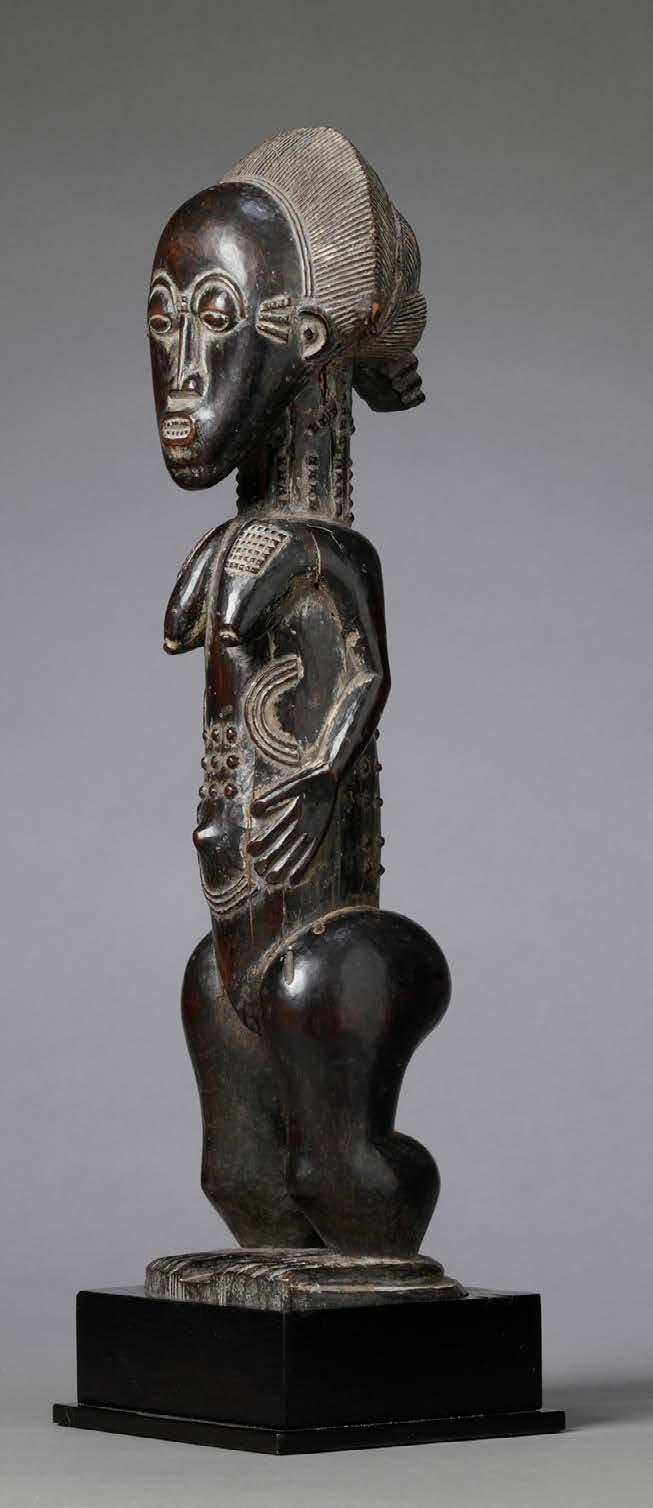
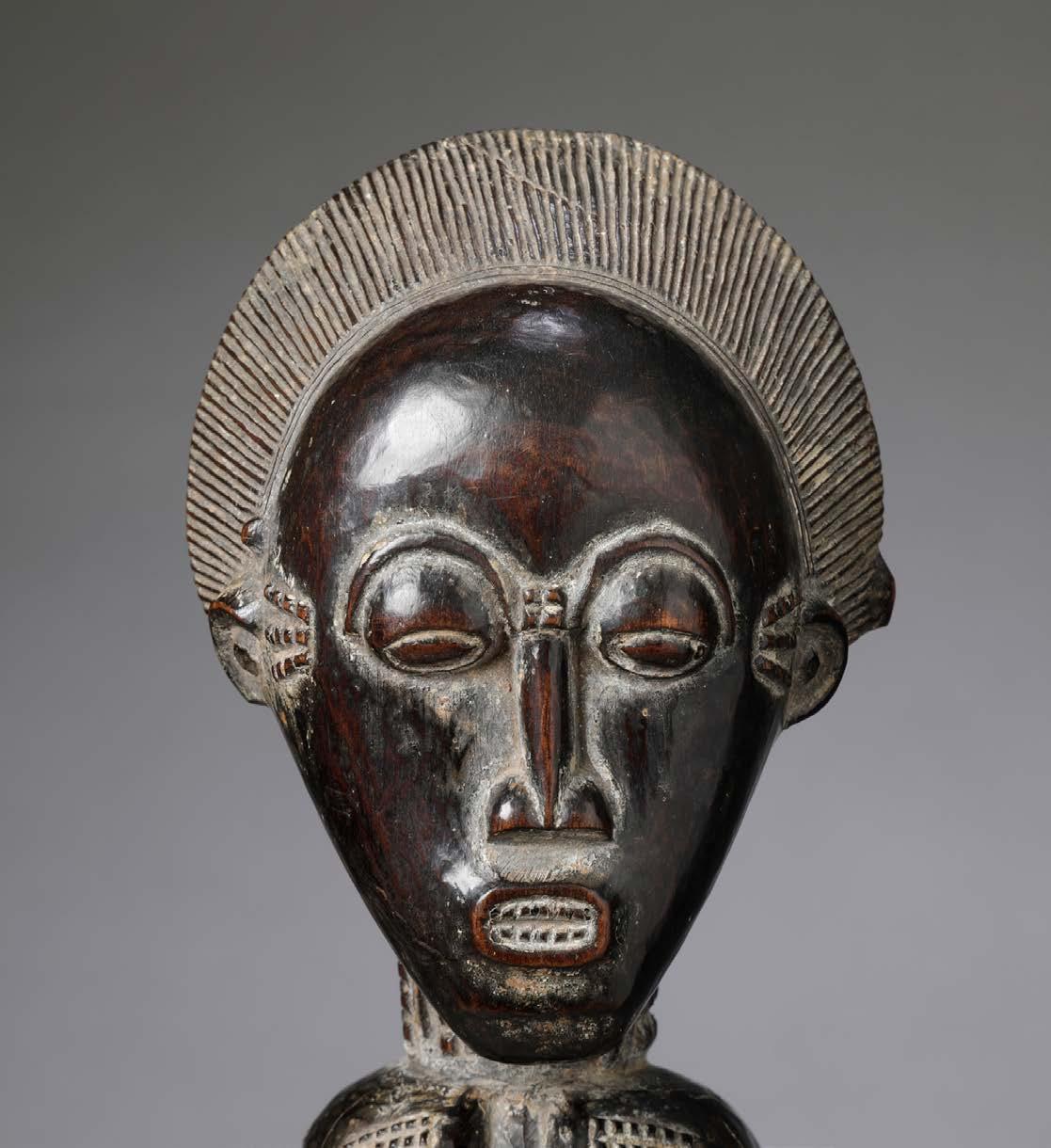
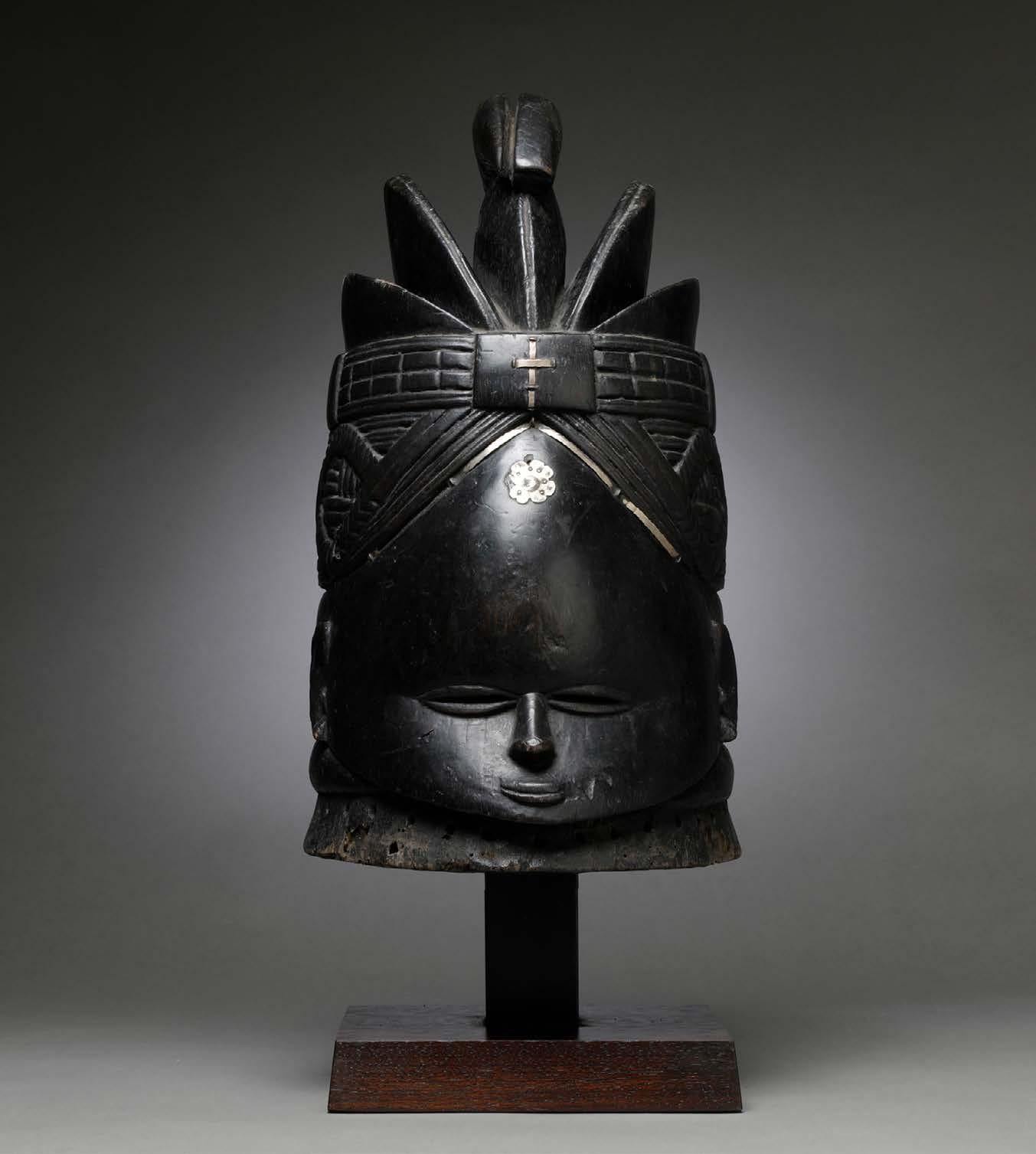
Early 20th century
Wood, metal, pigment
Height: 14 in; Width 9 ¼ in
PROVENANCE
Charles D.Miller, III, St. James, New York, USA, collected in the 1970s Private collection, USA
PUBLICATION HISTORY
Daniel Mato and Charles Miller III: SANDE masks and statues from Liberia and Sierra Leone illus p 51
Mende society is governed by a number of esoteric associations, foremost among which are the Sande women’s society and Poro men’s society. Both prepare young initiates for adulthood and make extensive use of masking. The helmet mask presented here, known as ndoli, represents a Sande guardian spirit. From generation to generation, such masks served to induct the new adults of the tribe into the next chapter of their lives, welcoming them to fully embrace the knowledge and lineage of their ancestors.
The classic features of the ndoli are all on show in the present example: a high, domed forehead over a small and
serene face, bunched neck rings, and a fantastically detailed coiffure, all of which express a vision of idealized beauty. Brass applications adorn the brow and crown with bright accents. Relief-carved details wrap around the entirety of the head, with a layered double braid motif spanning from temple to temple over a striated underwork. Five semi-discs form the crown-like top of the coiffure, conferring a regal and resplendent impression that is a quintessential quality of these masks. The finial is believed to represent a bush cow horn.
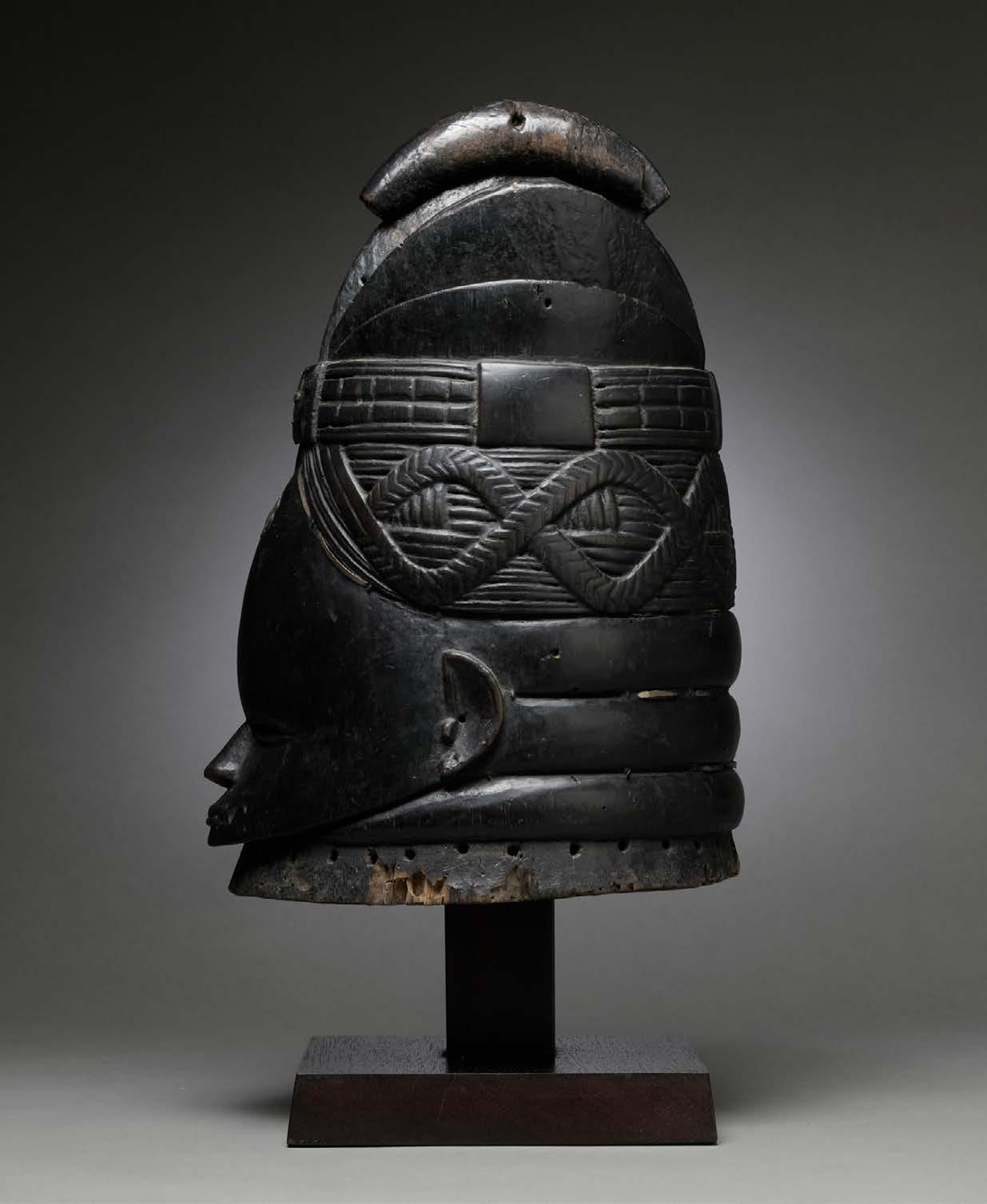


15th – 16th century
Walrus ivory
Length: 21 in
Excavated on St. Lawrence Island
Jeffrey Myers, New York
While modern technology has replaced many of the traditional tools that enabled Inuit to survive in the Arctic, one of their fundamental hunting weapons, the harpoon, continues in use to the present day. Essentially, the harpoon is a spear designed to secure a detachable point, or head, to an animal; a line attached to the head allows the hunter to retrieve the quarry once it has been struck. Harpoons have a wide distribution throughout the world, but it is among the Inuit that the most complex pre-industrial forms were developed. The primary use of the Inuit harpoon was for hunting sea mammals, both at breathing holes in the sea ice and in open water, although in some arctic areas the harpoon was used for fish as well.
Harpoon heads generally belonged to one of two major groups. One kind had a projecting tang at its base, which was inserted into a socket piece on the end of the shaft. Barbs projecting from the body of this type of head ensured that it stayed embedded in the flesh of the animal once it
was harpooned. The other variety had a socket at the base of the head to receive the tip of a foreshaft. After being thrust into an animal, one or more spurs at the base of the head dug into its flesh; tension on the harpoon line, which passed through a hole above the socket, then caused the head to rotate, preventing it from slipping out. This variety, called the toggle harpoon head, was the more common form in Inuit cultures and is the type offered for sale here.
This harpoon comprises 3 parts: harpoon head, the foreshaft and a socket piece. The socket piece would have been inserted into a long shaft. The harpoon shaft was made of wood, if available, as it would then float. In areas where wood could not be obtained, the shafts were fashioned from narwhal tusk or from several pieces of bone or antler spliced together. It is extremely rare to find 3 original elements of an excavated harpoon. Additionally, the example on offer has an unusual curve as it was probably designed to enable the hunter to reach animals hiding under ice floes.
